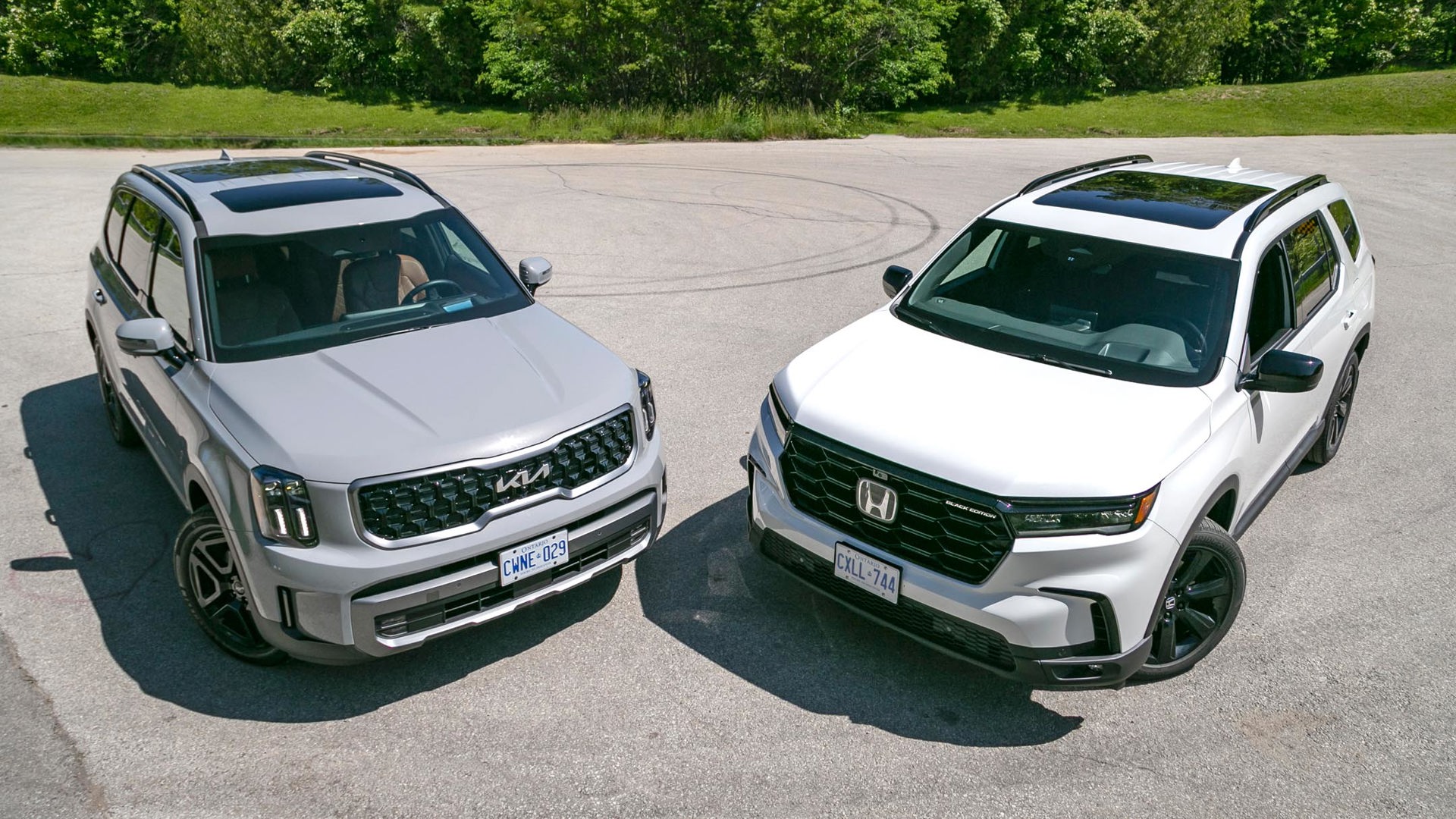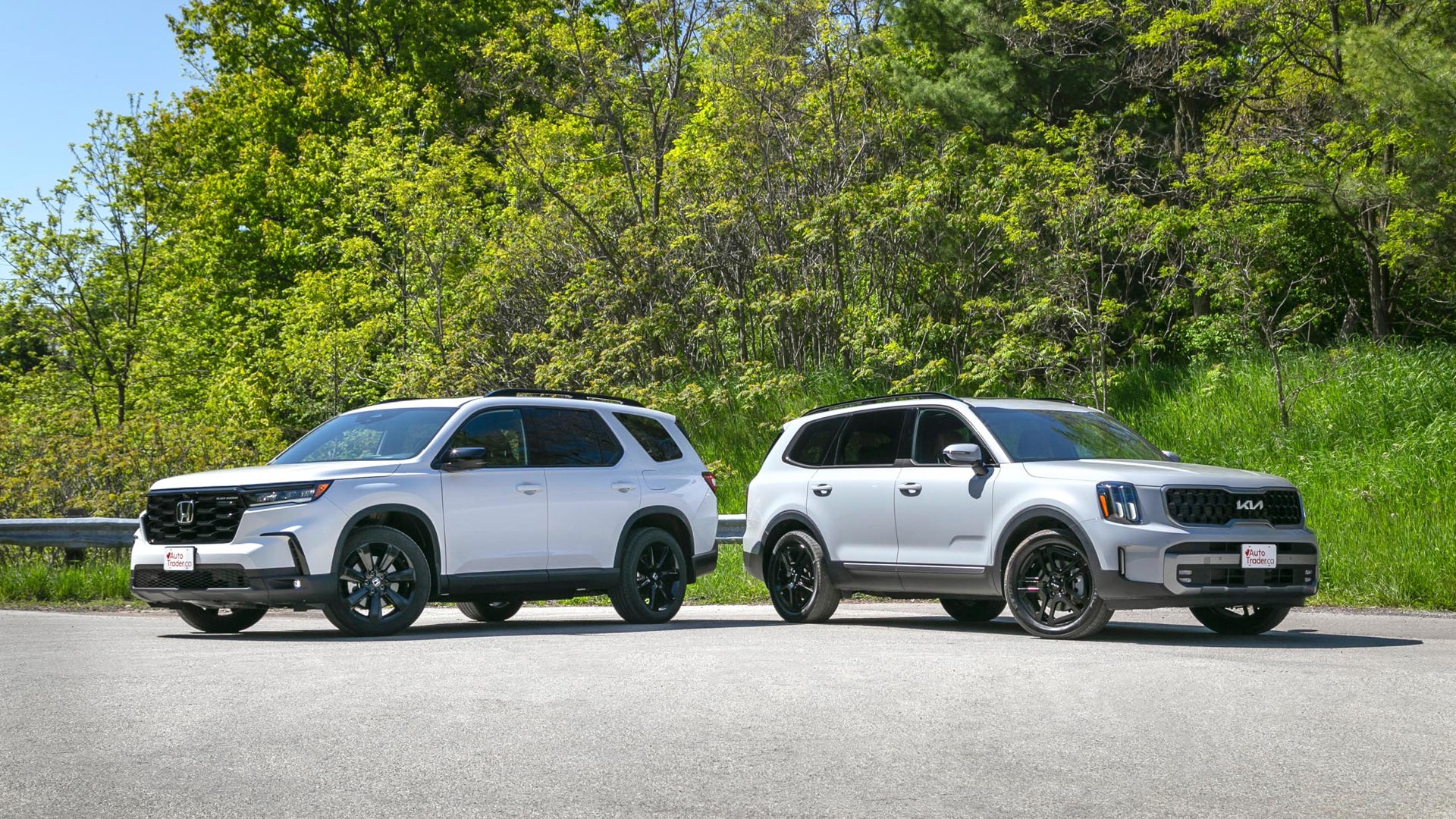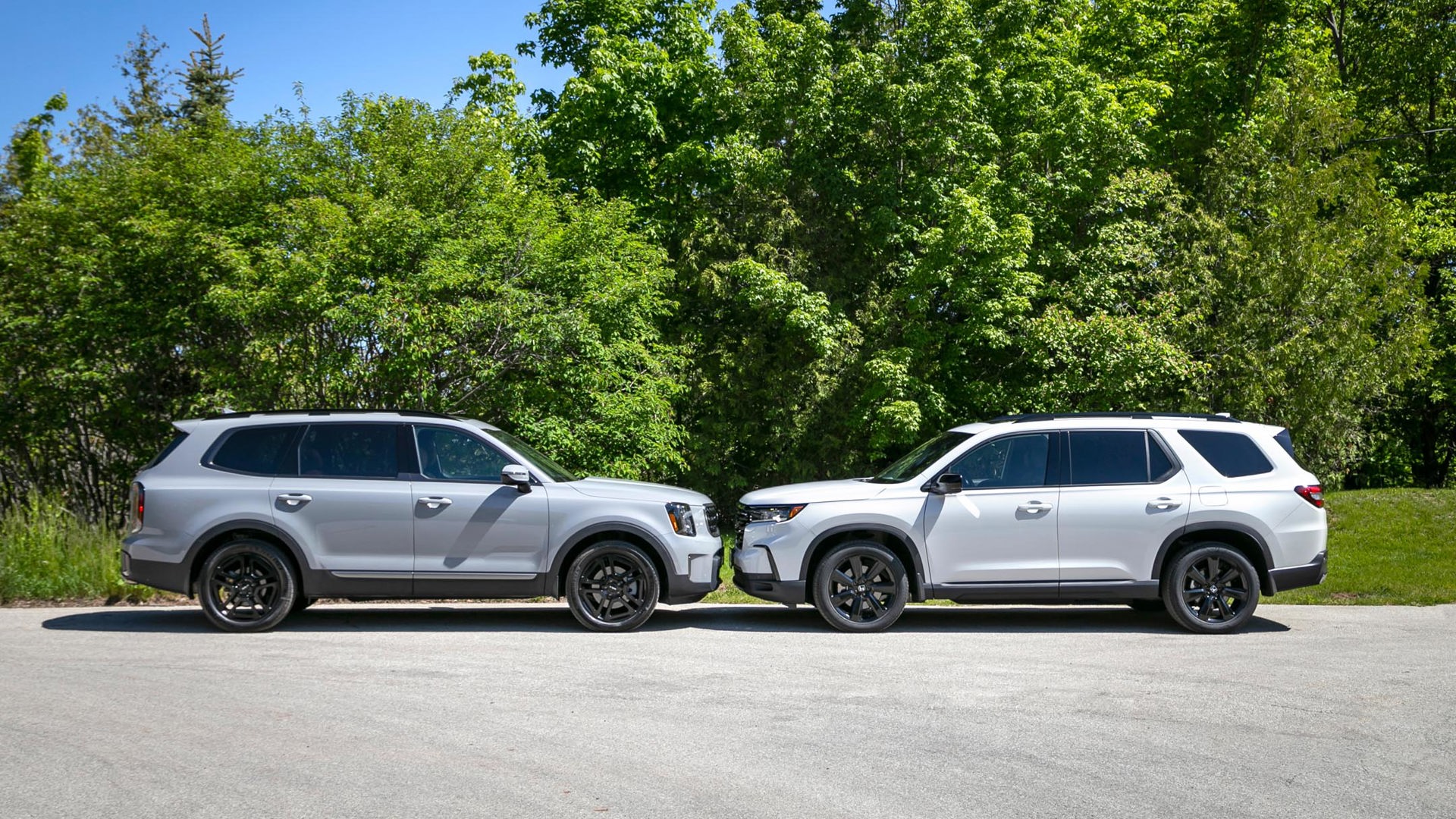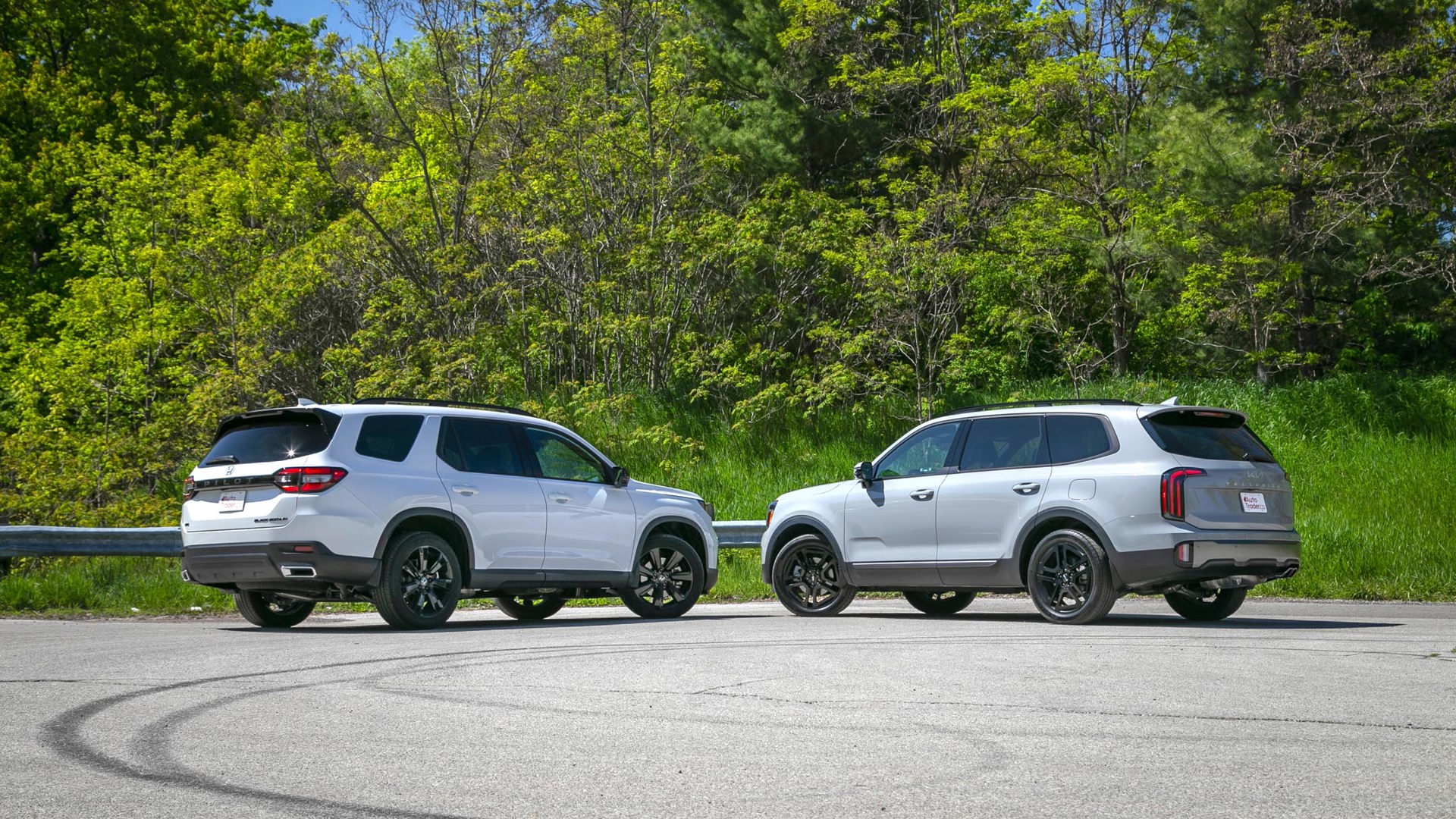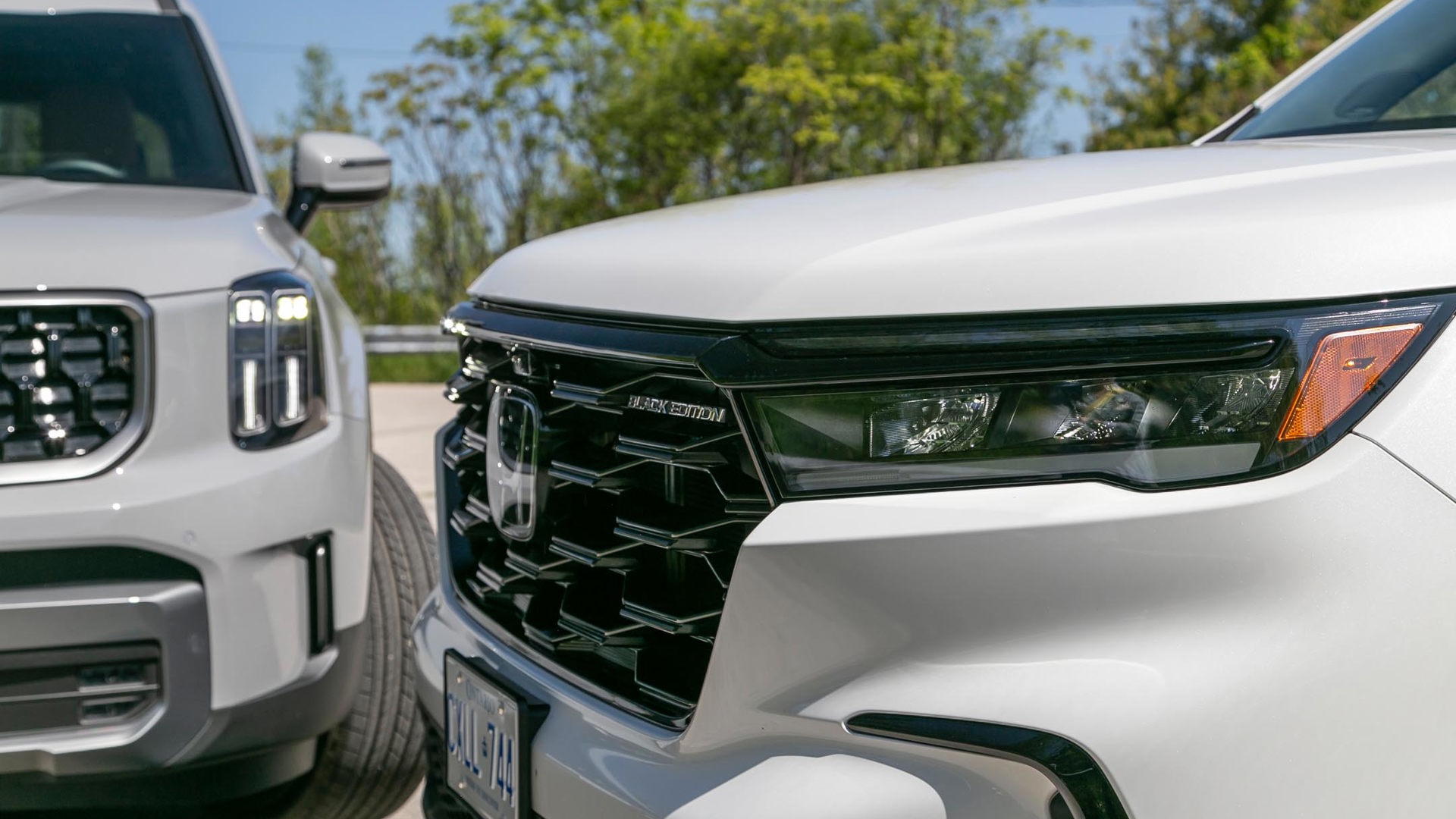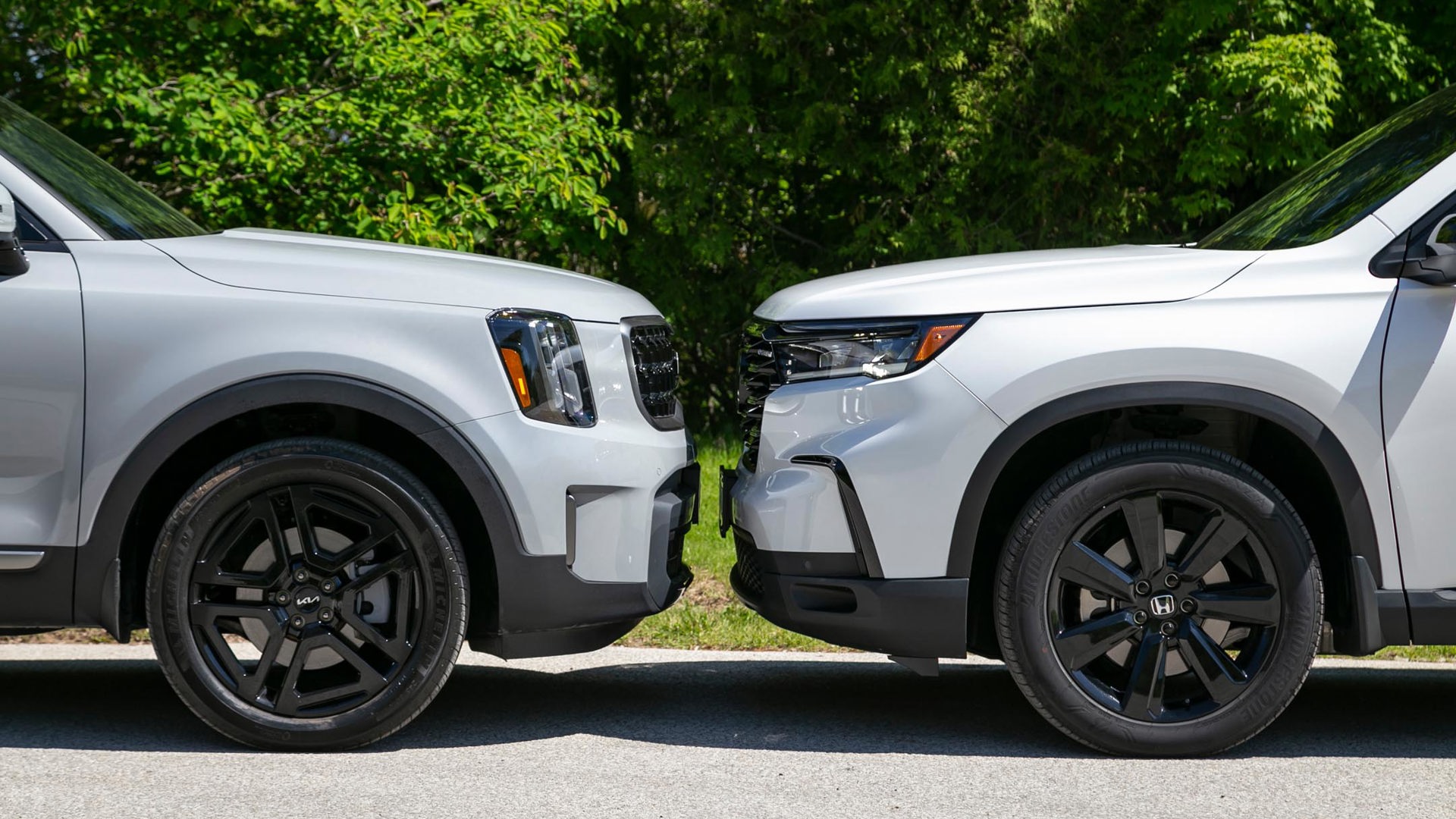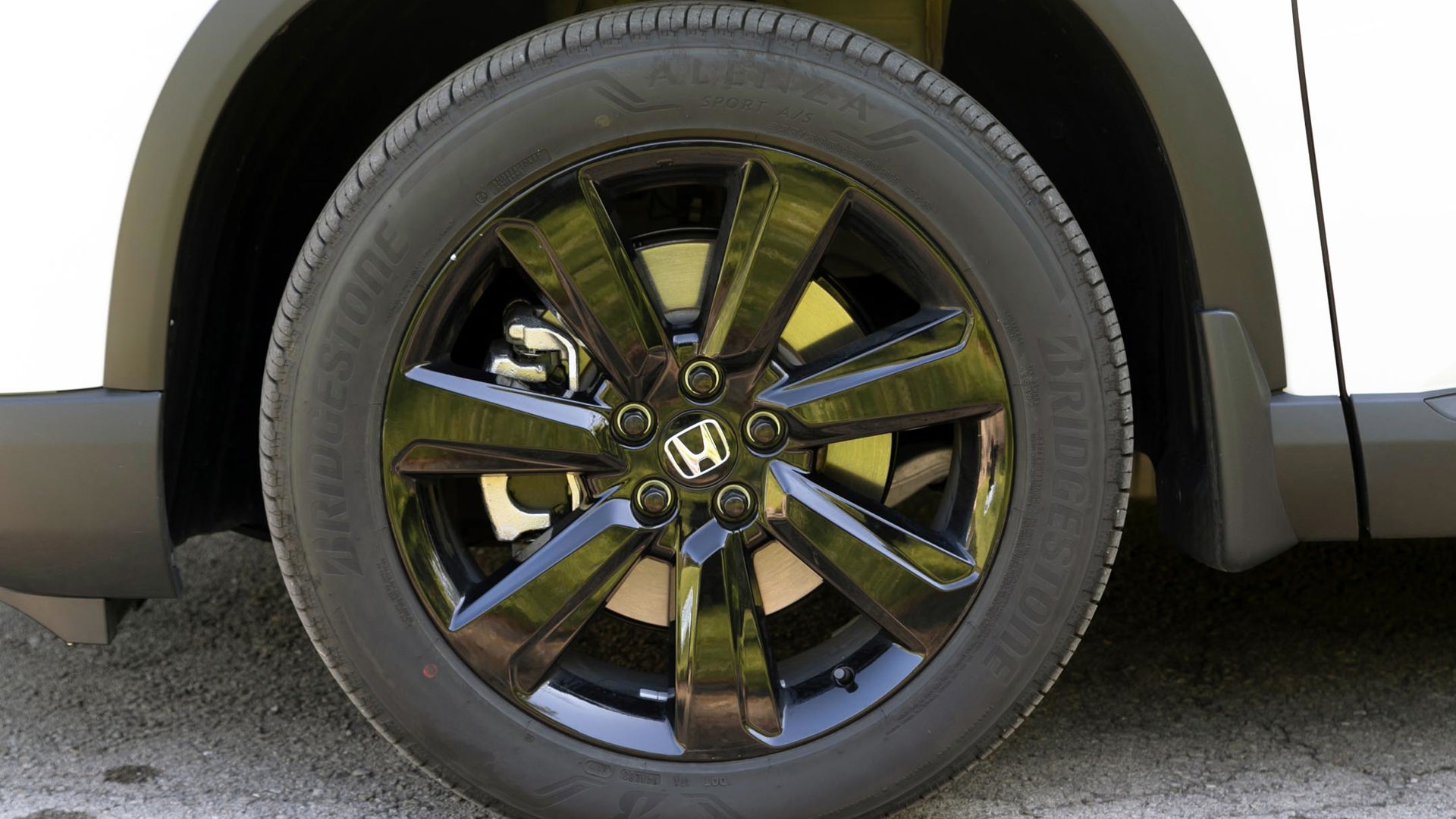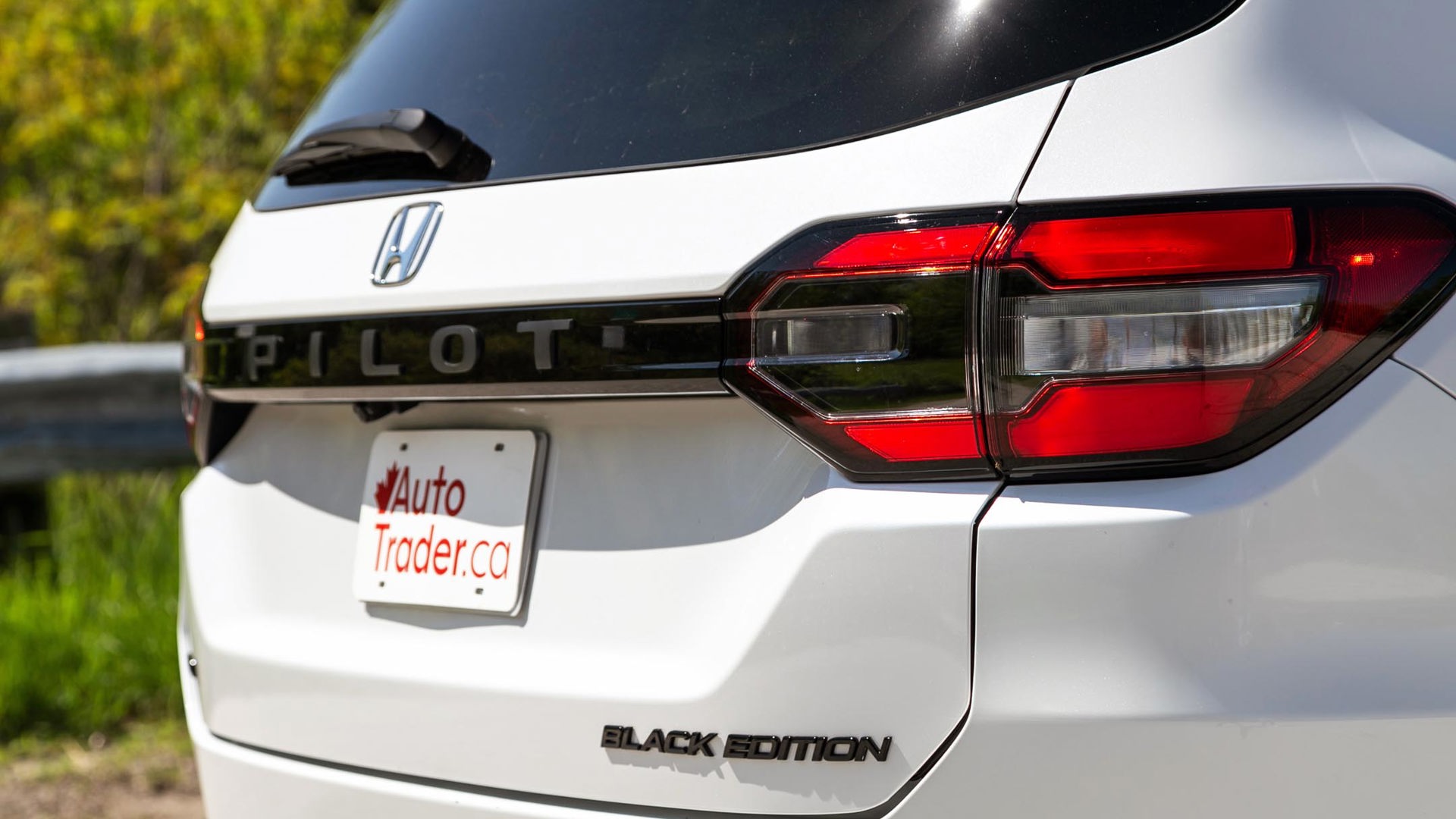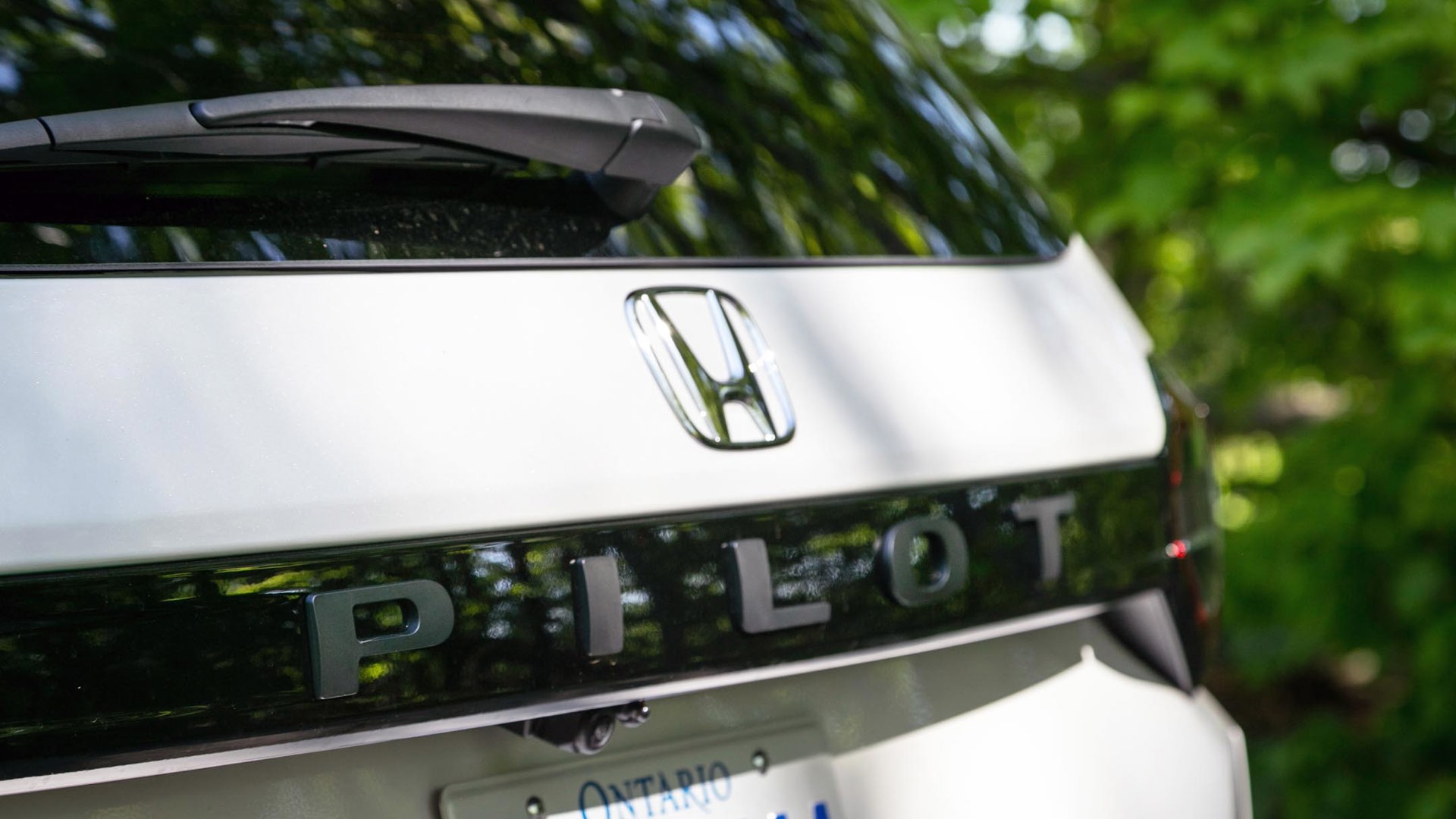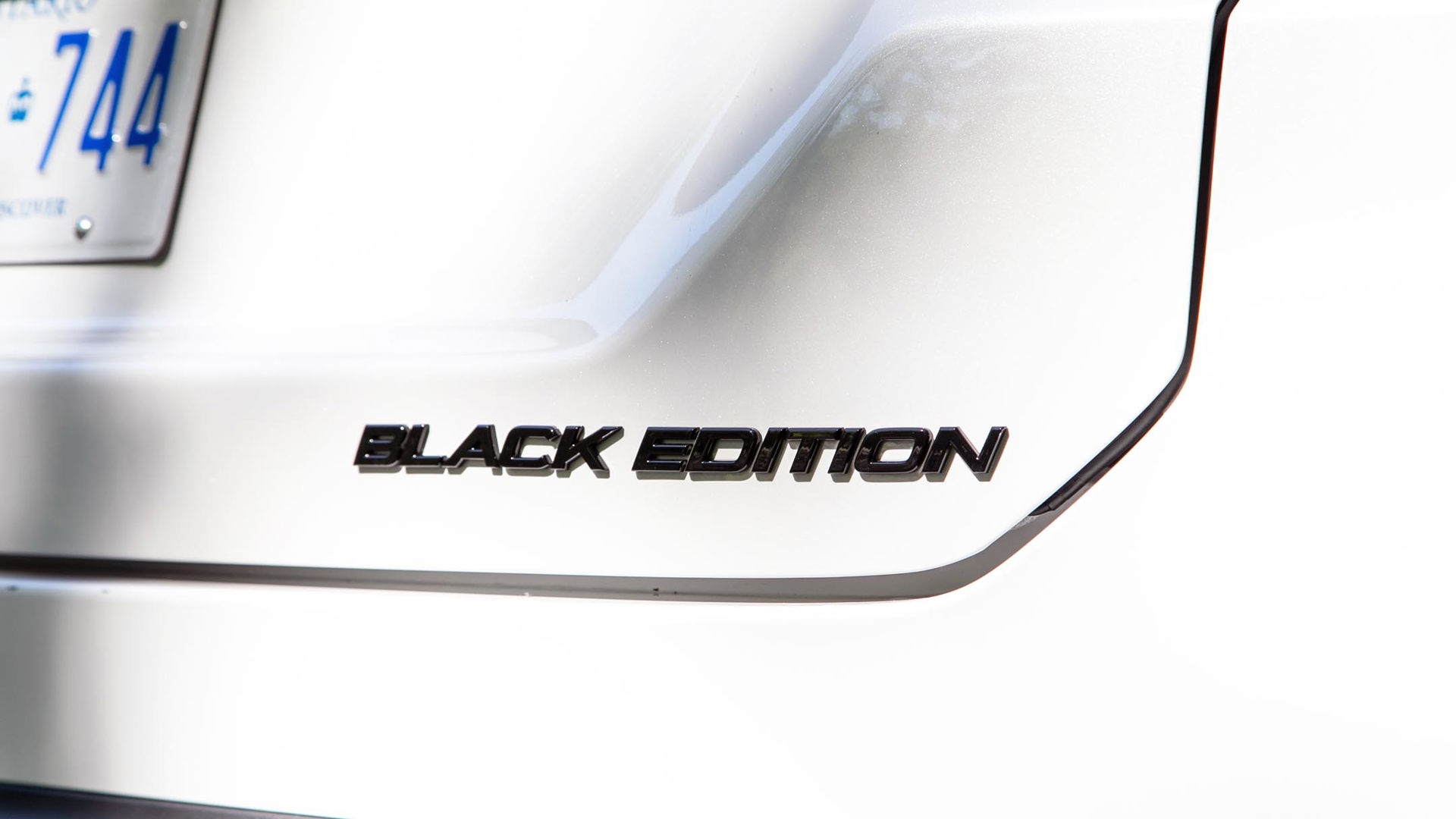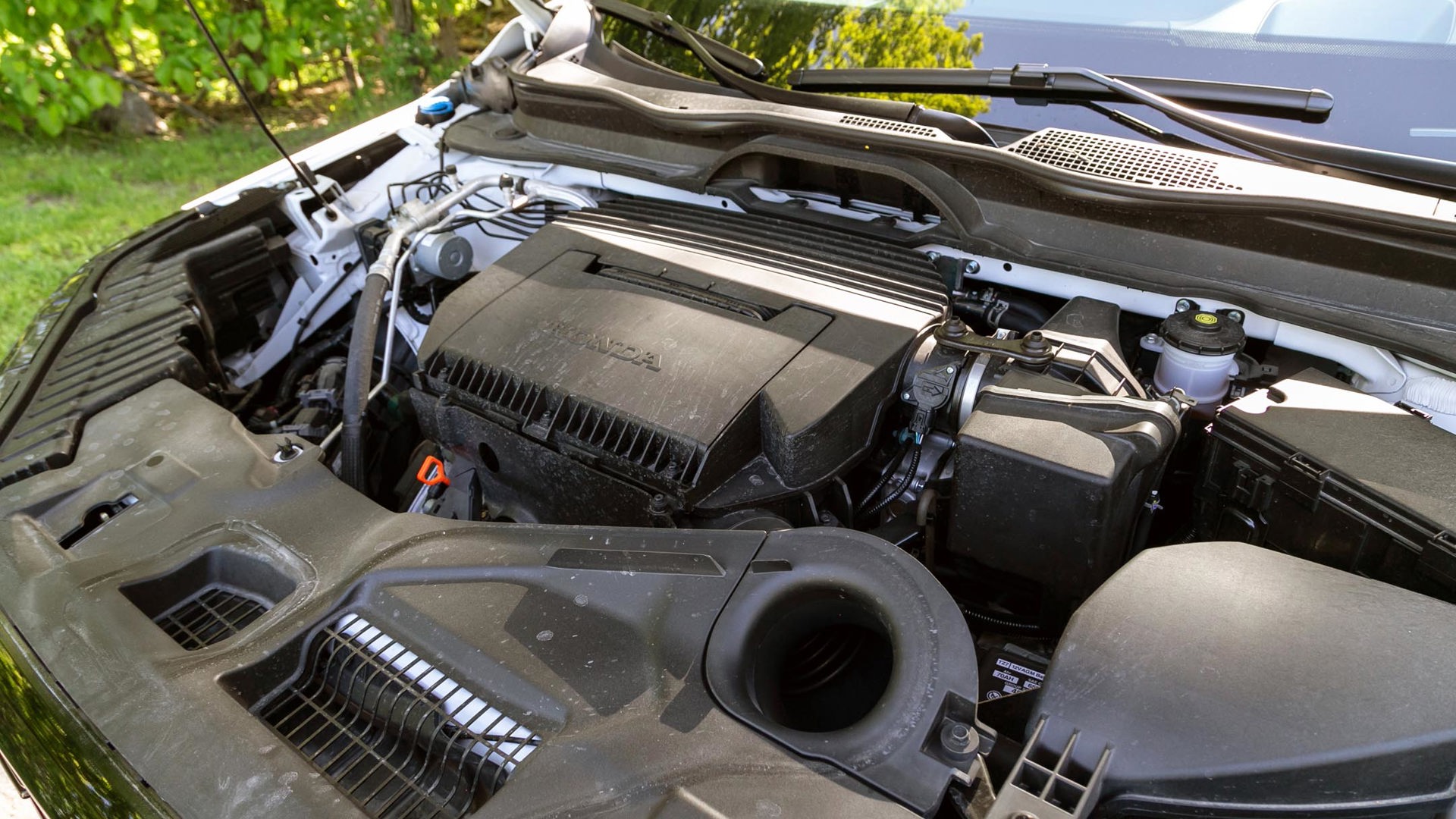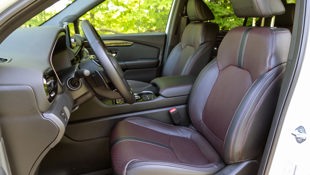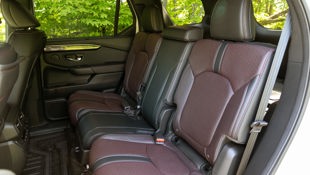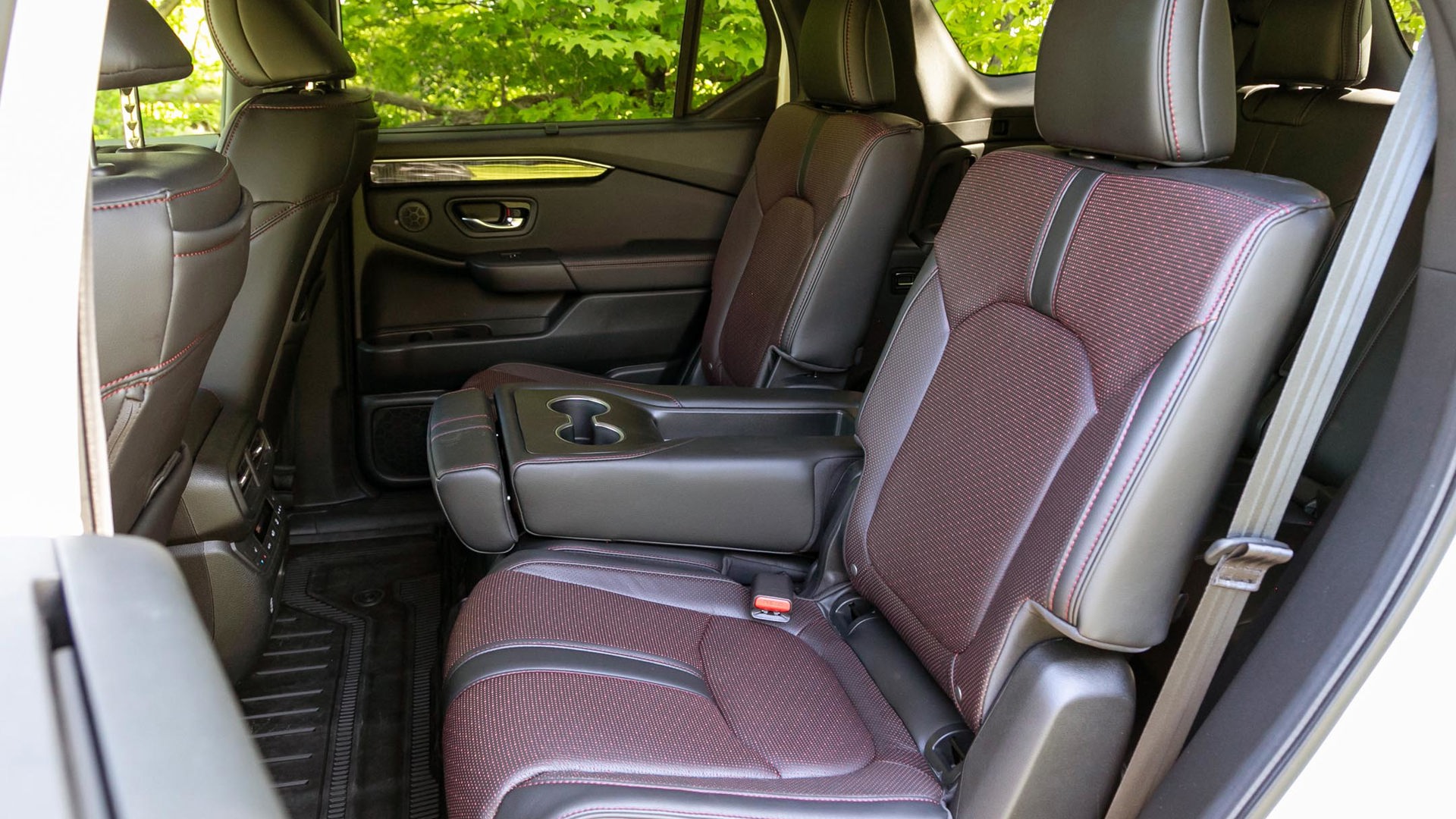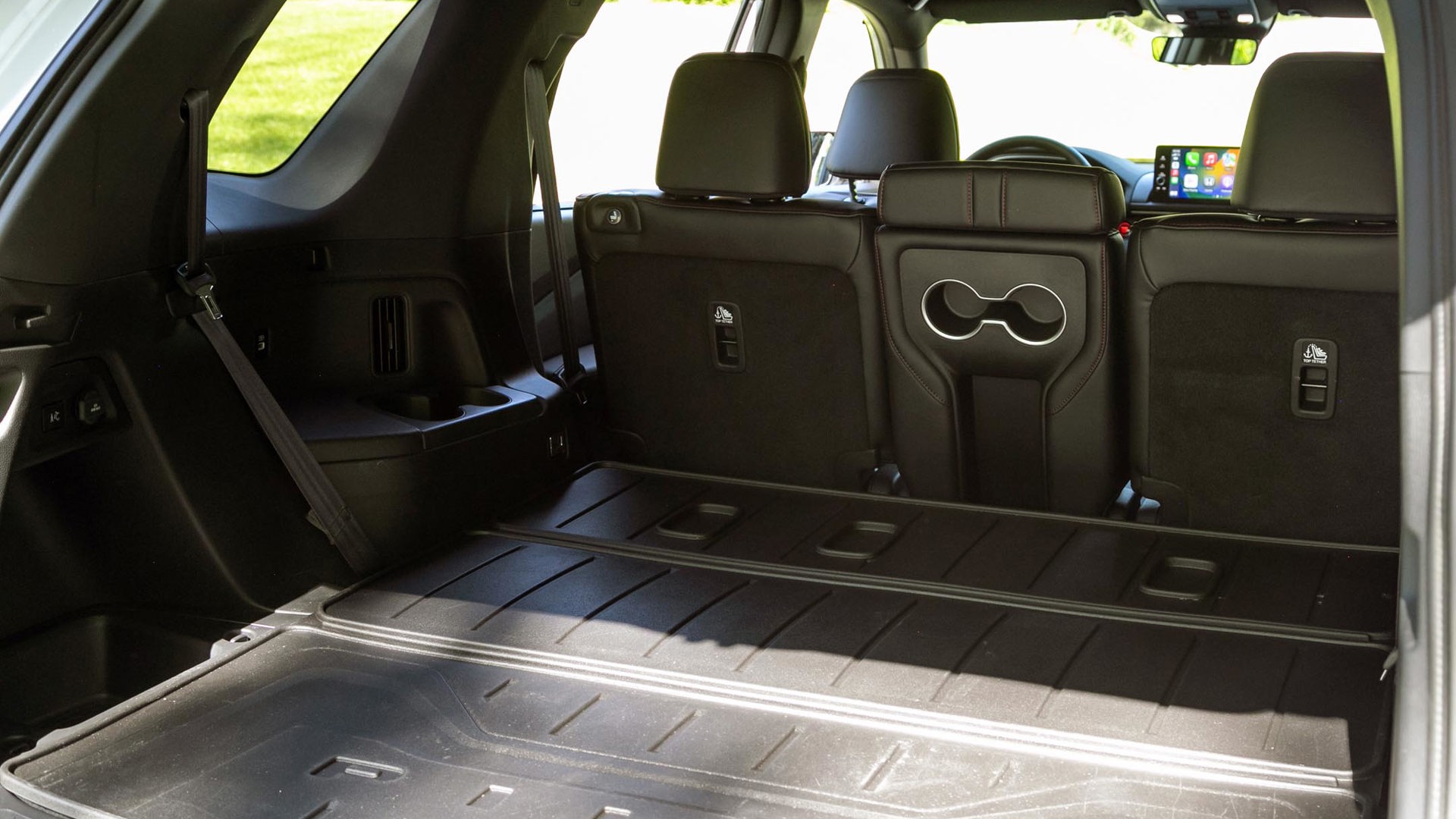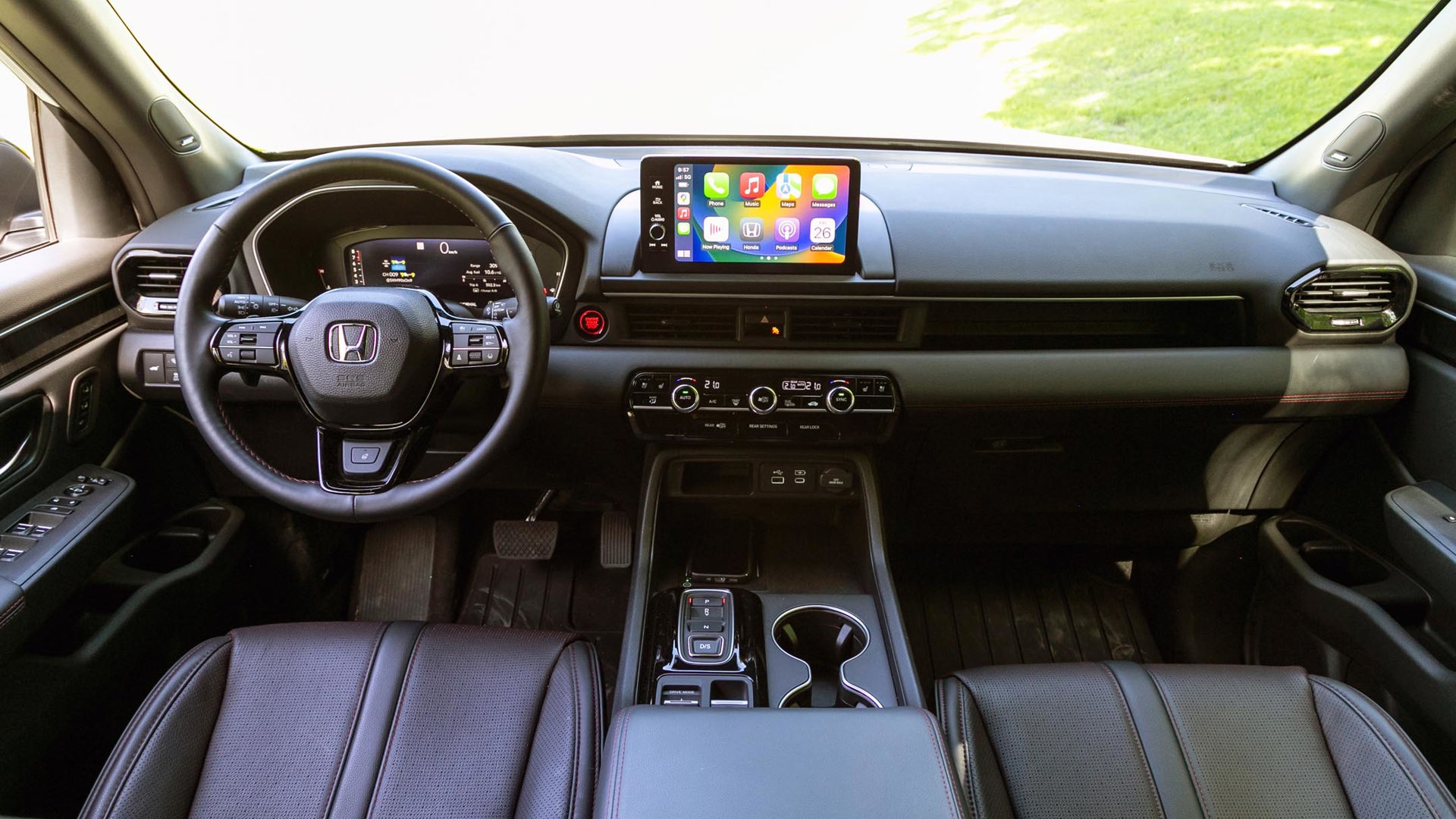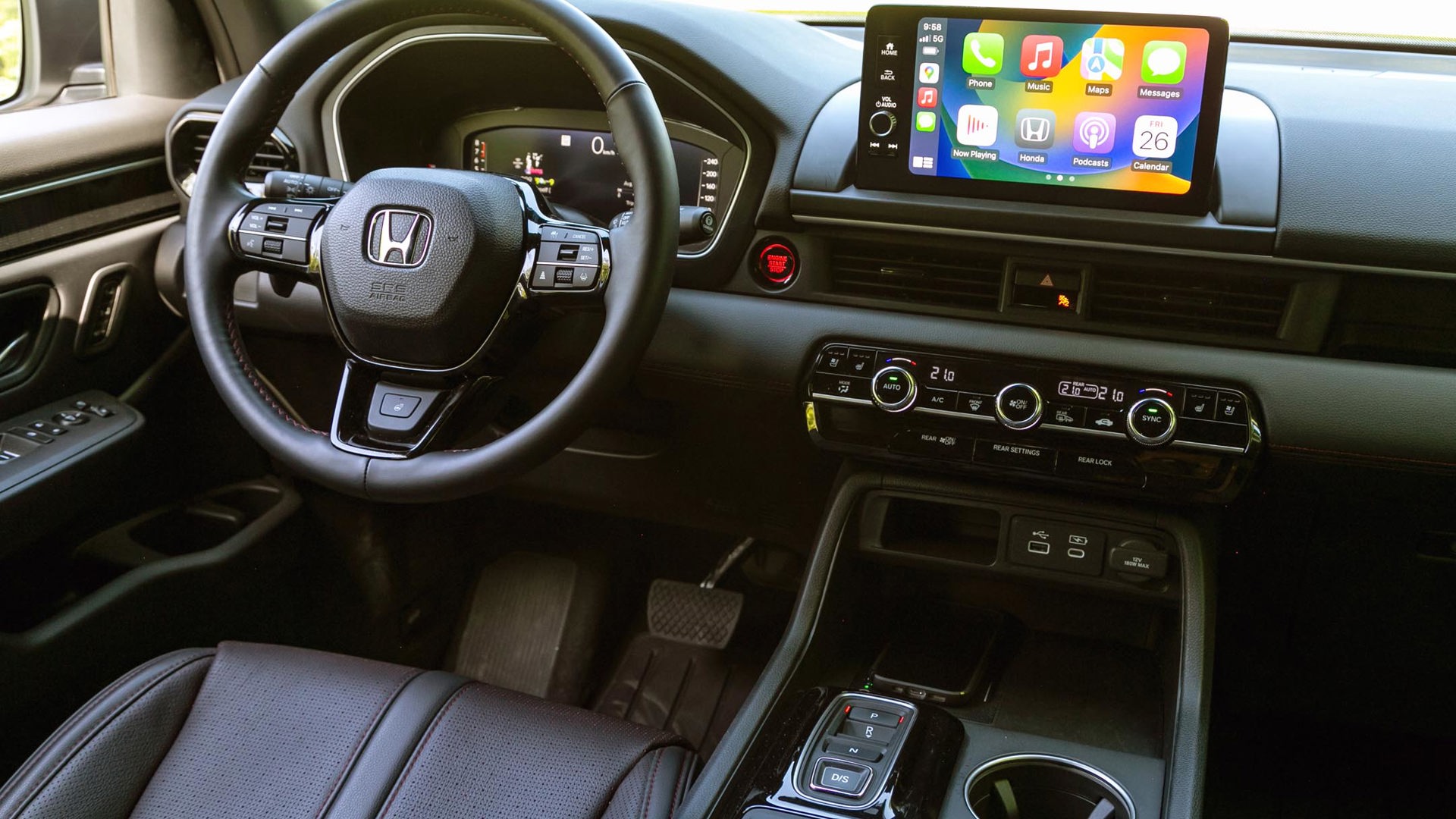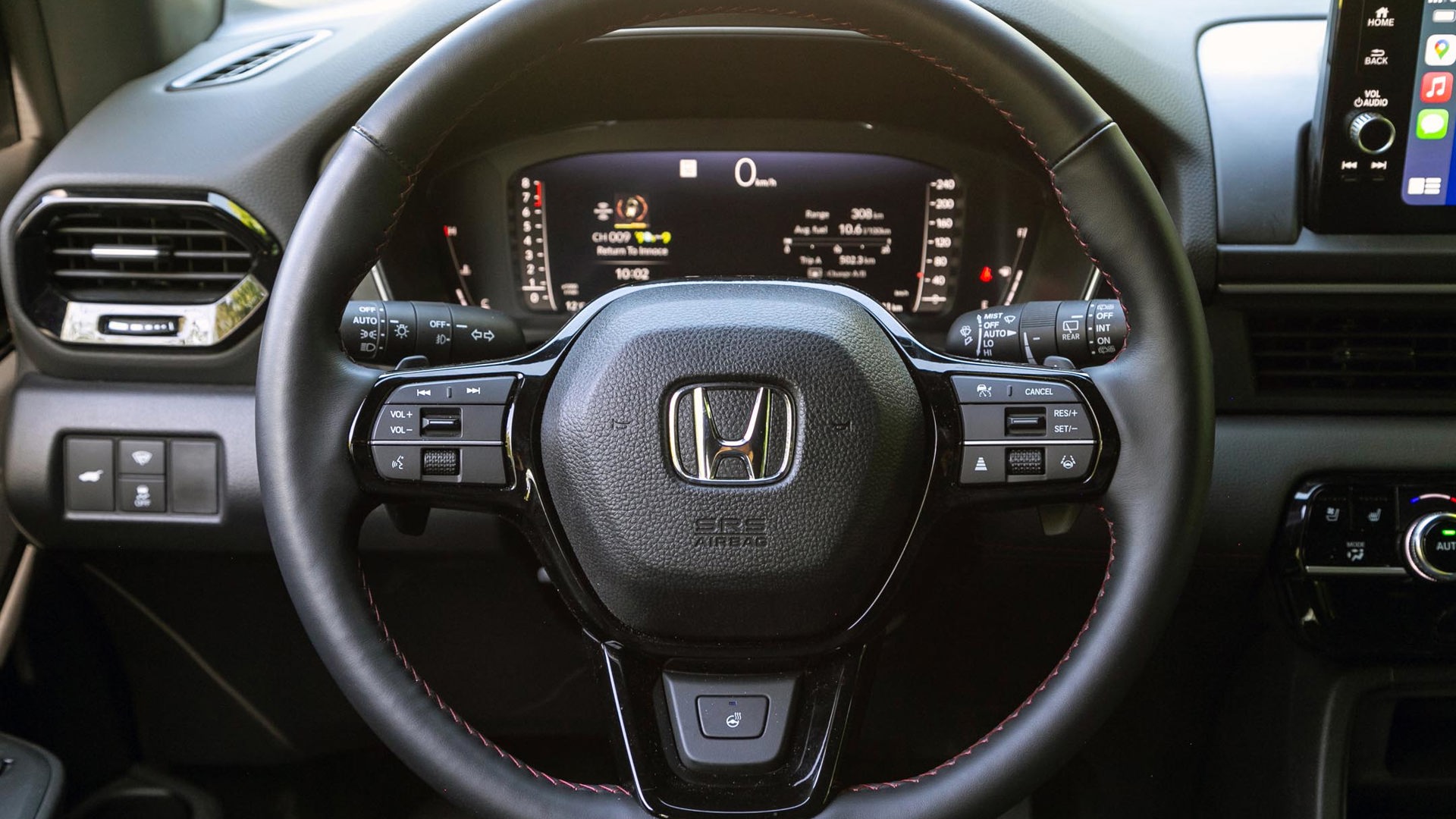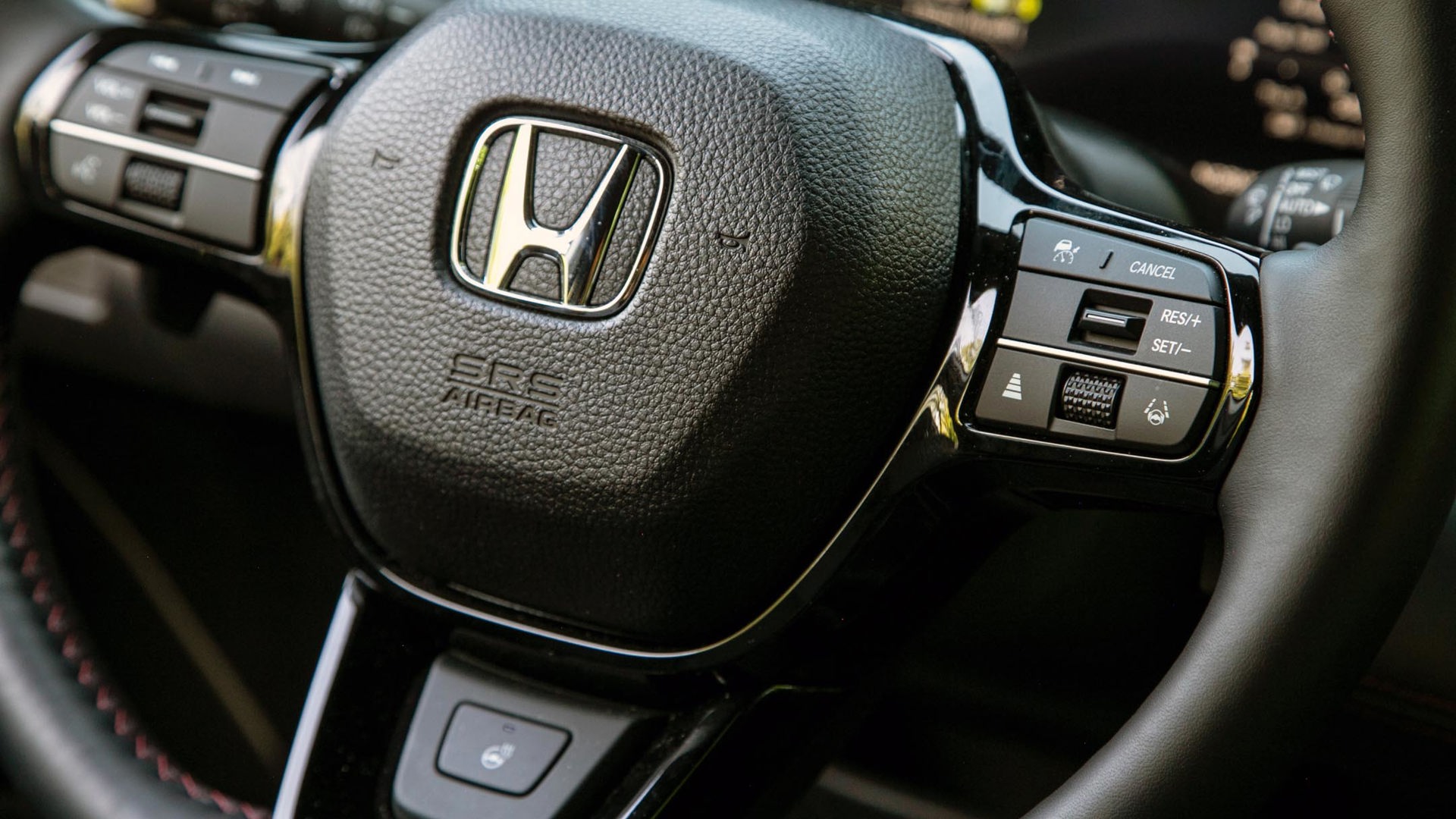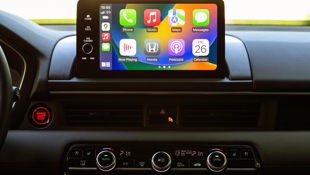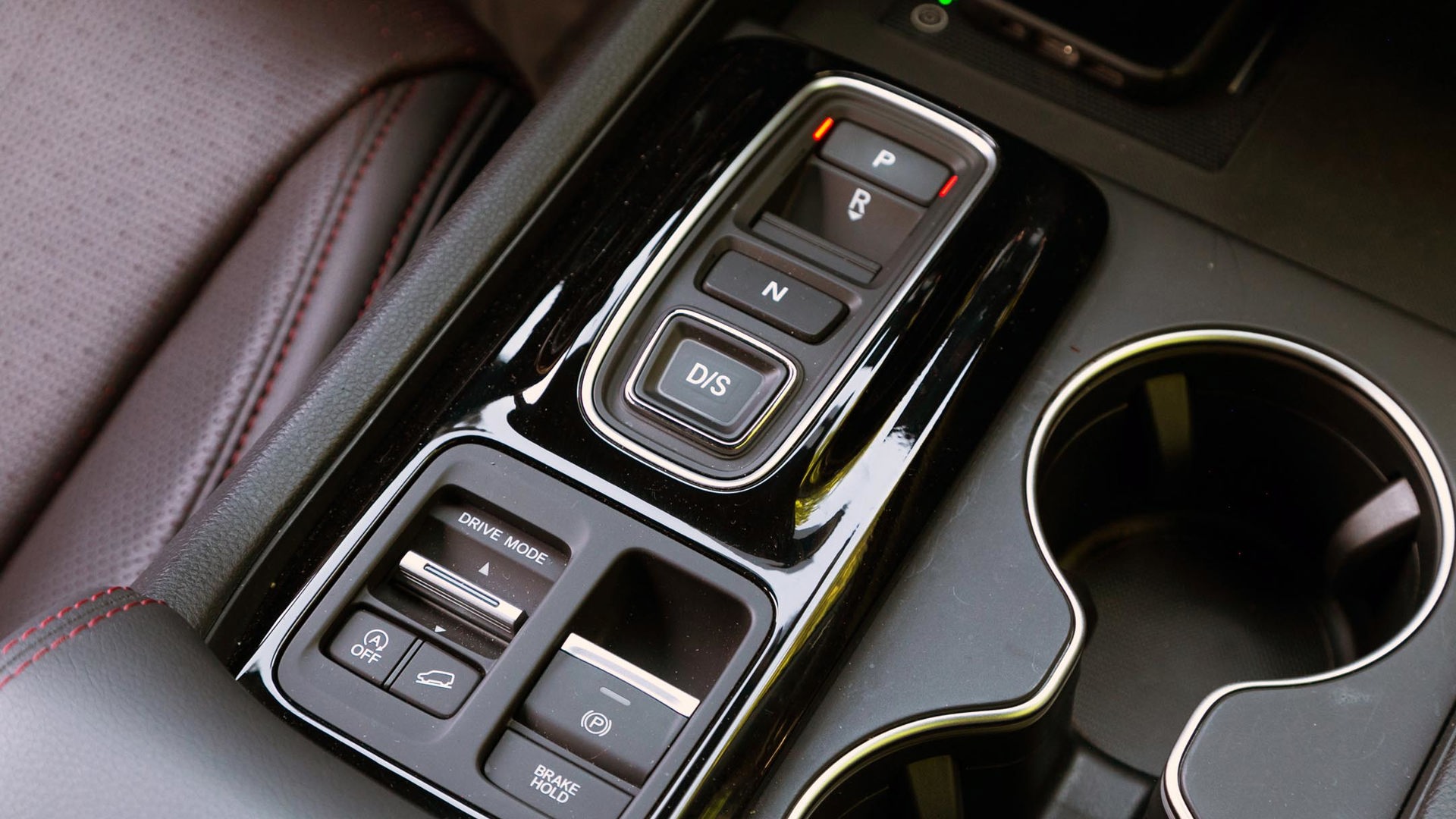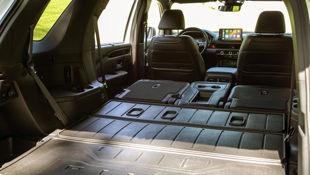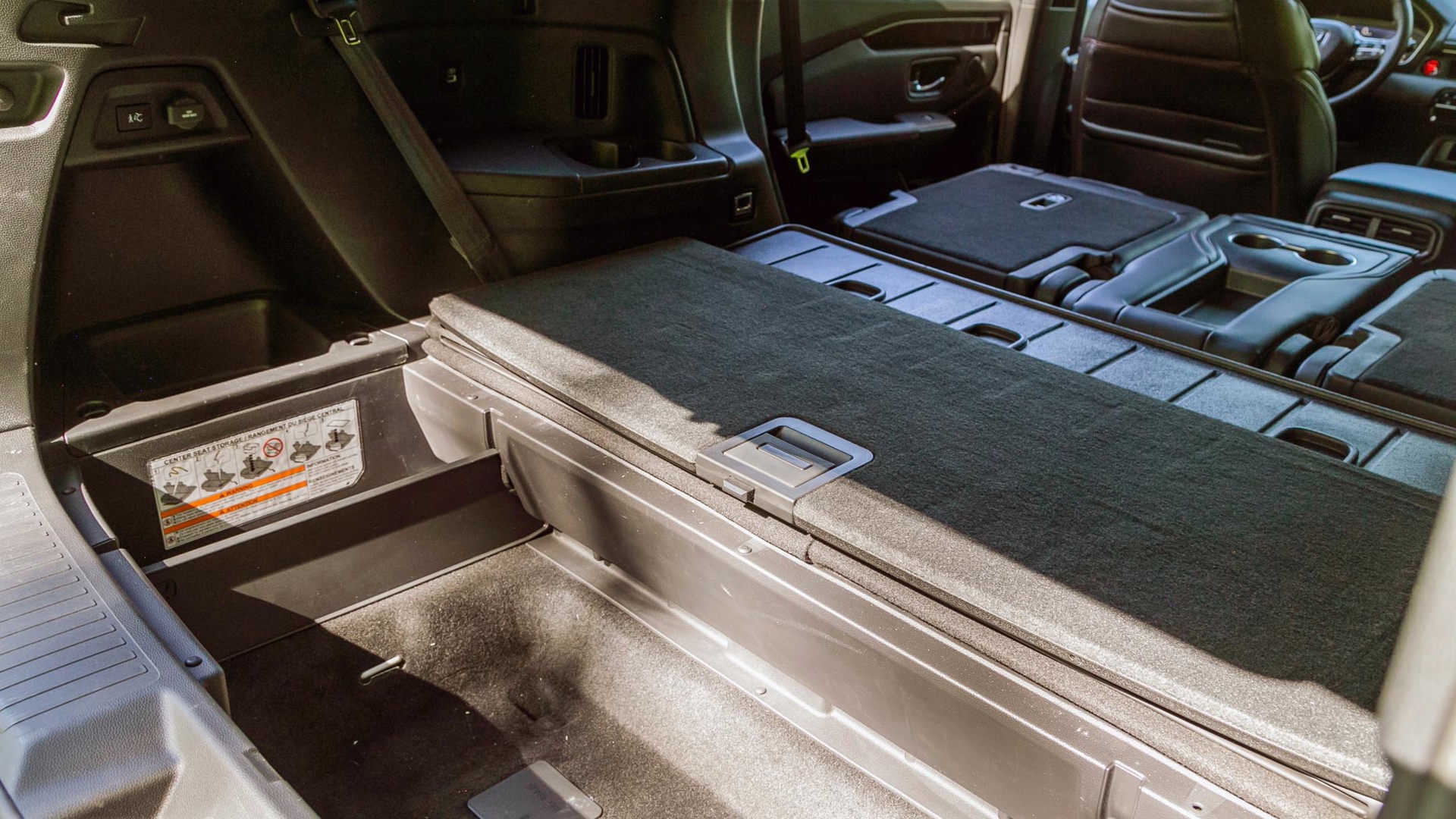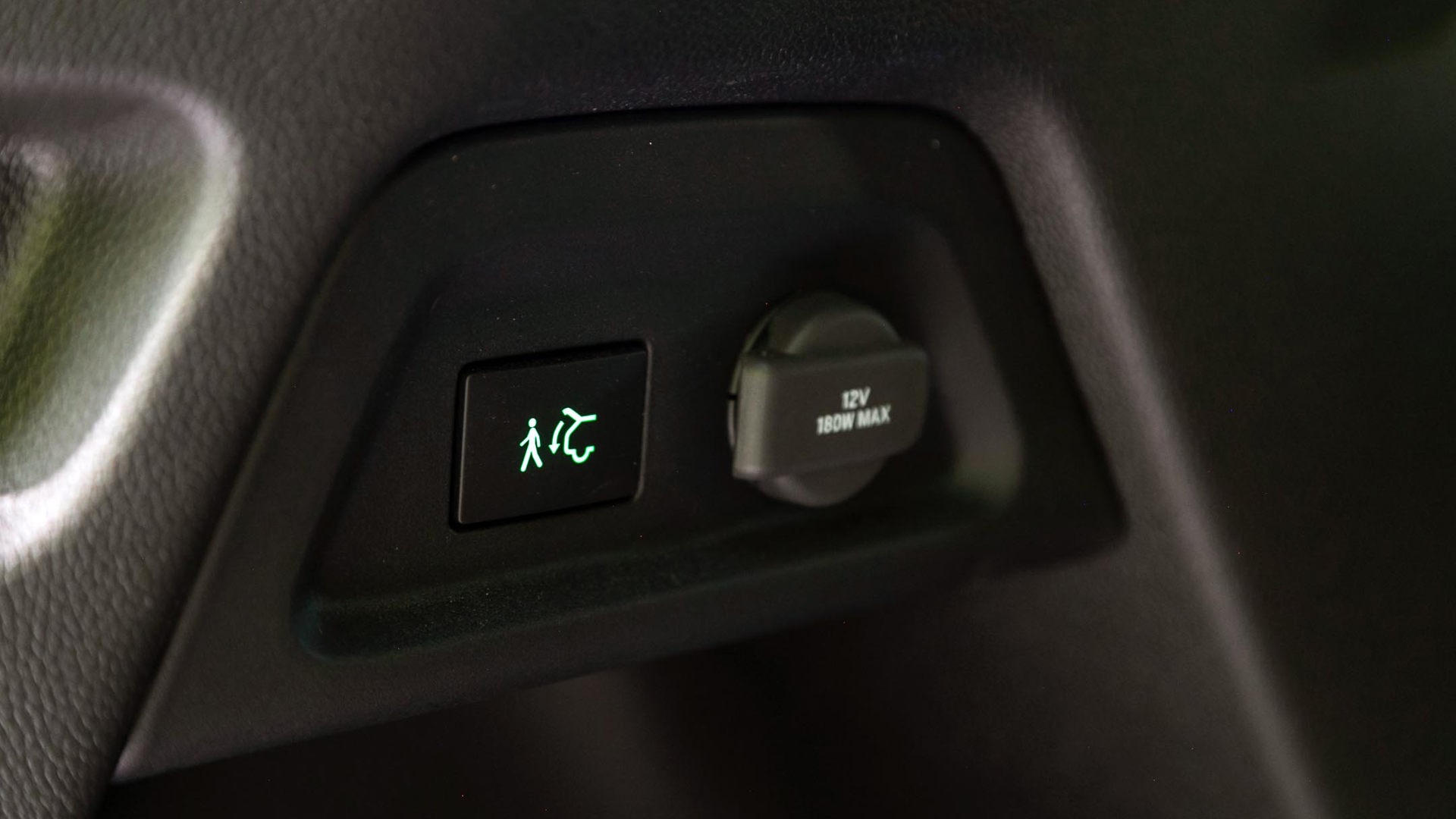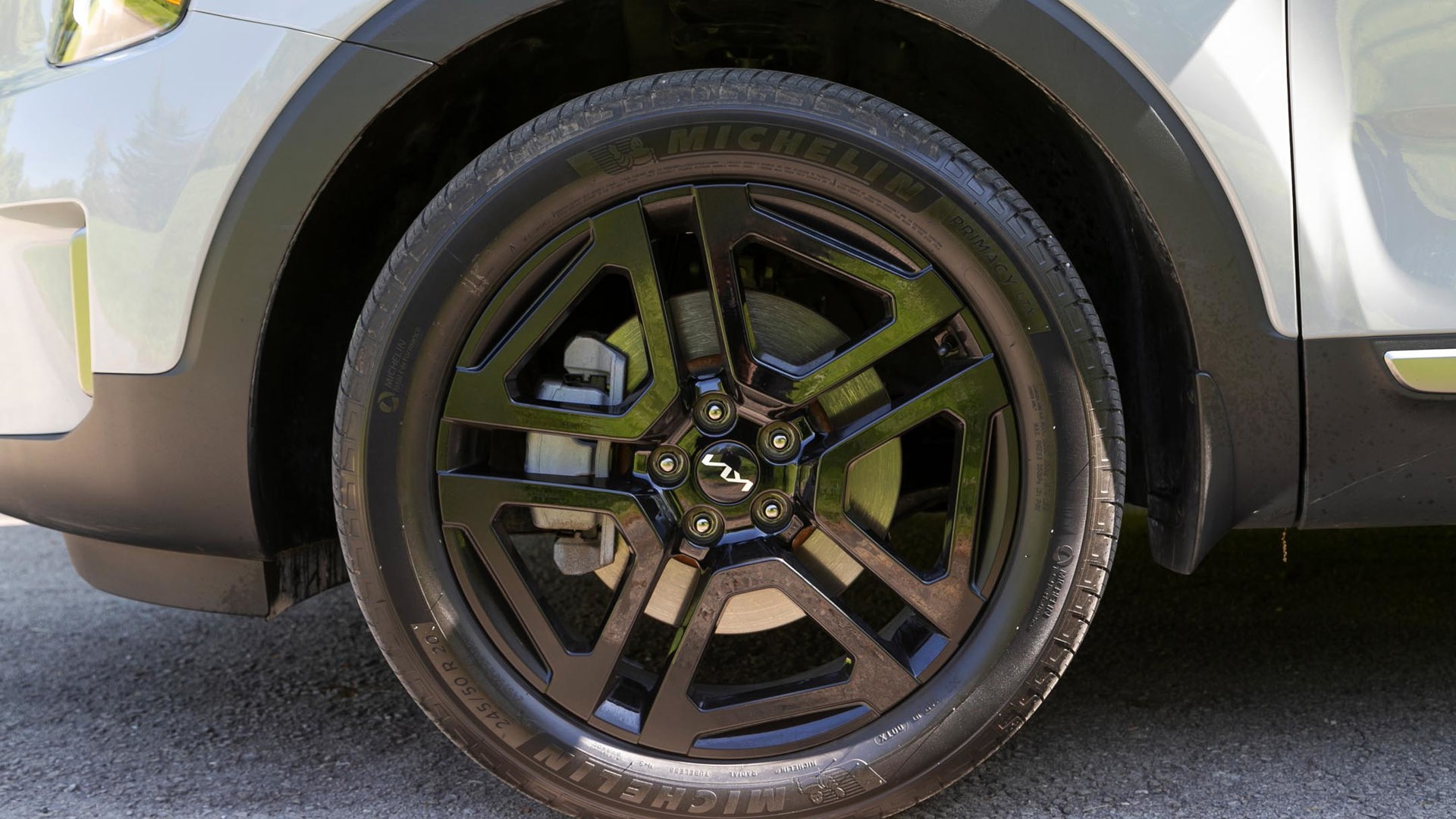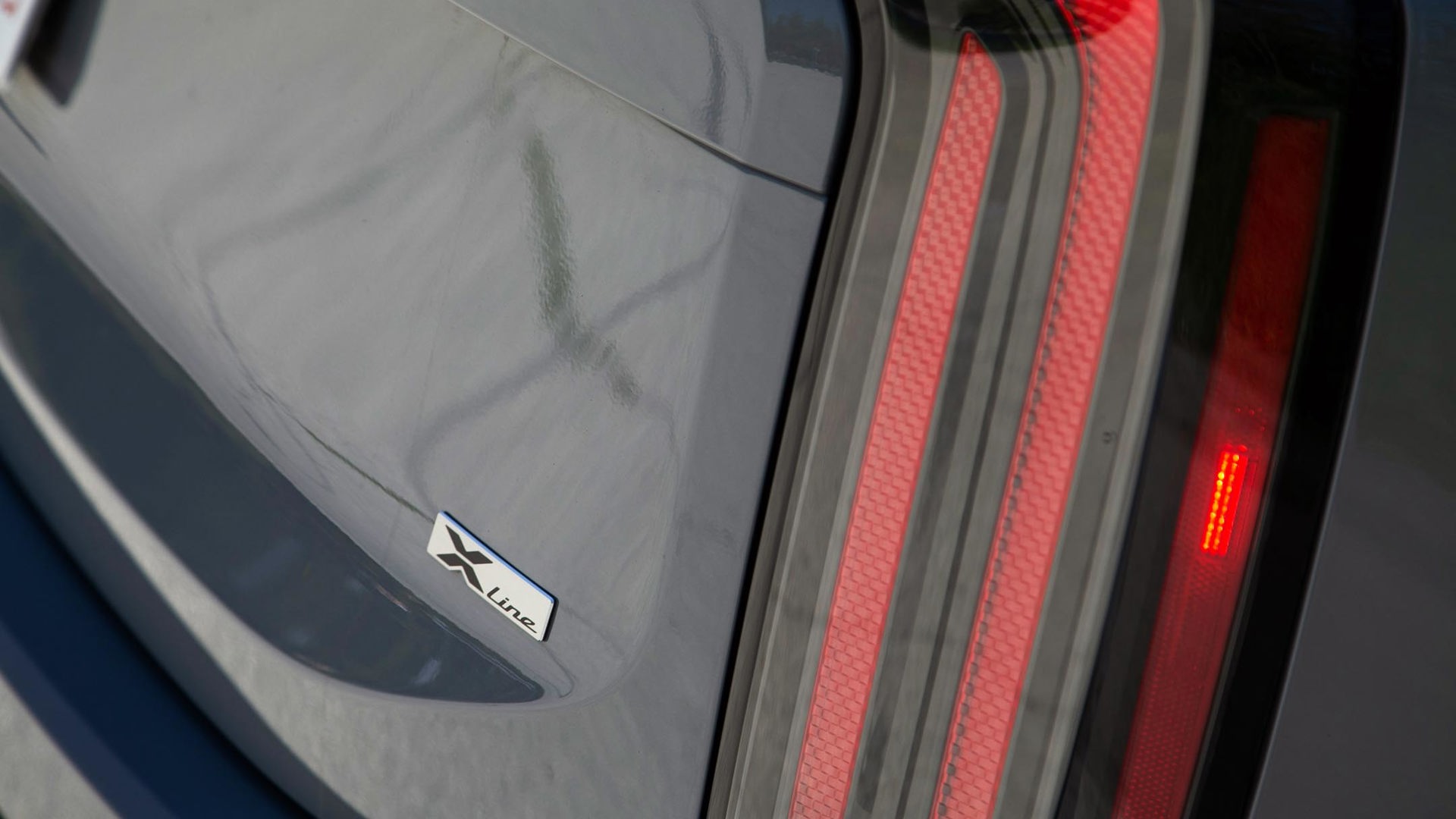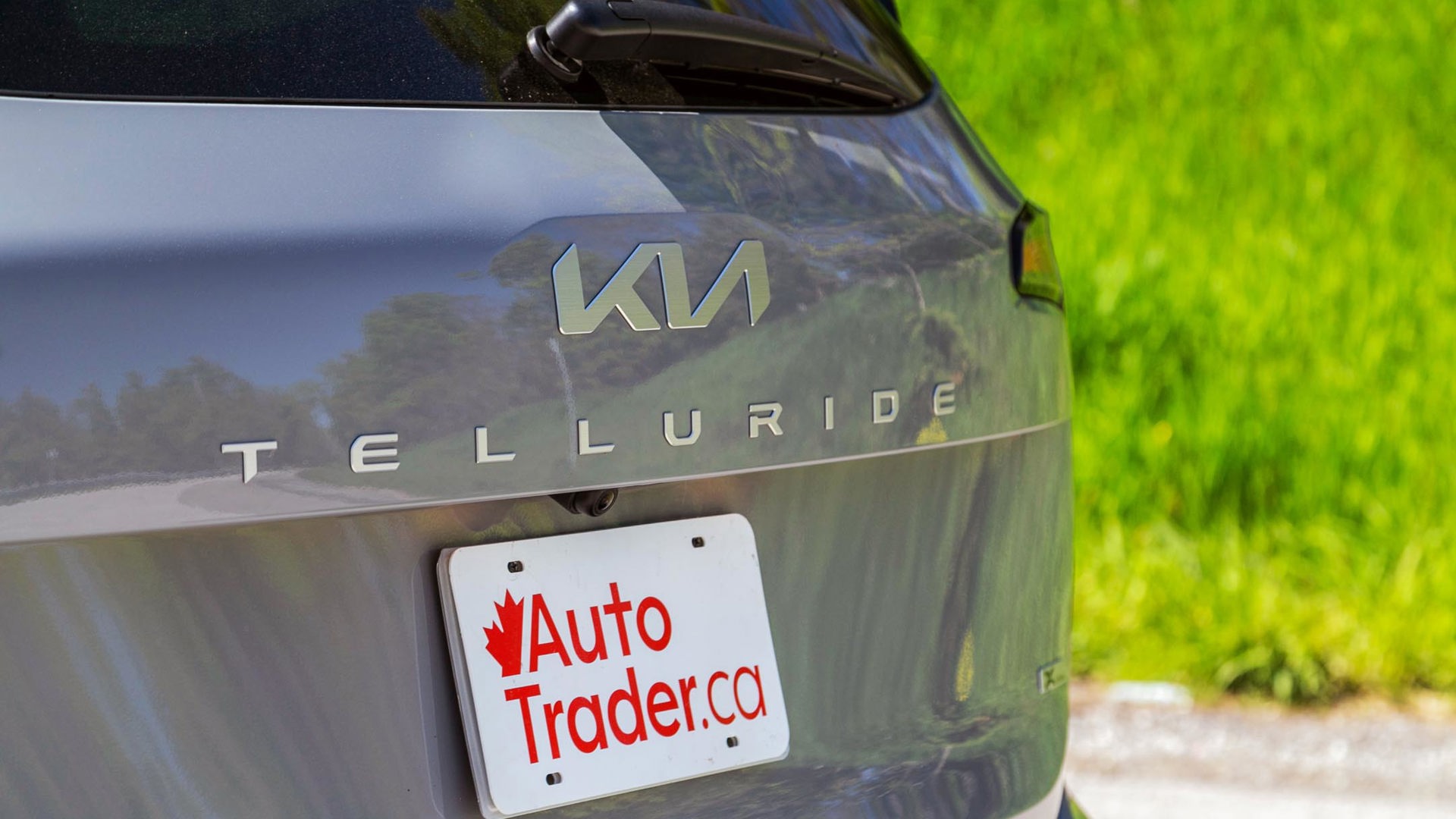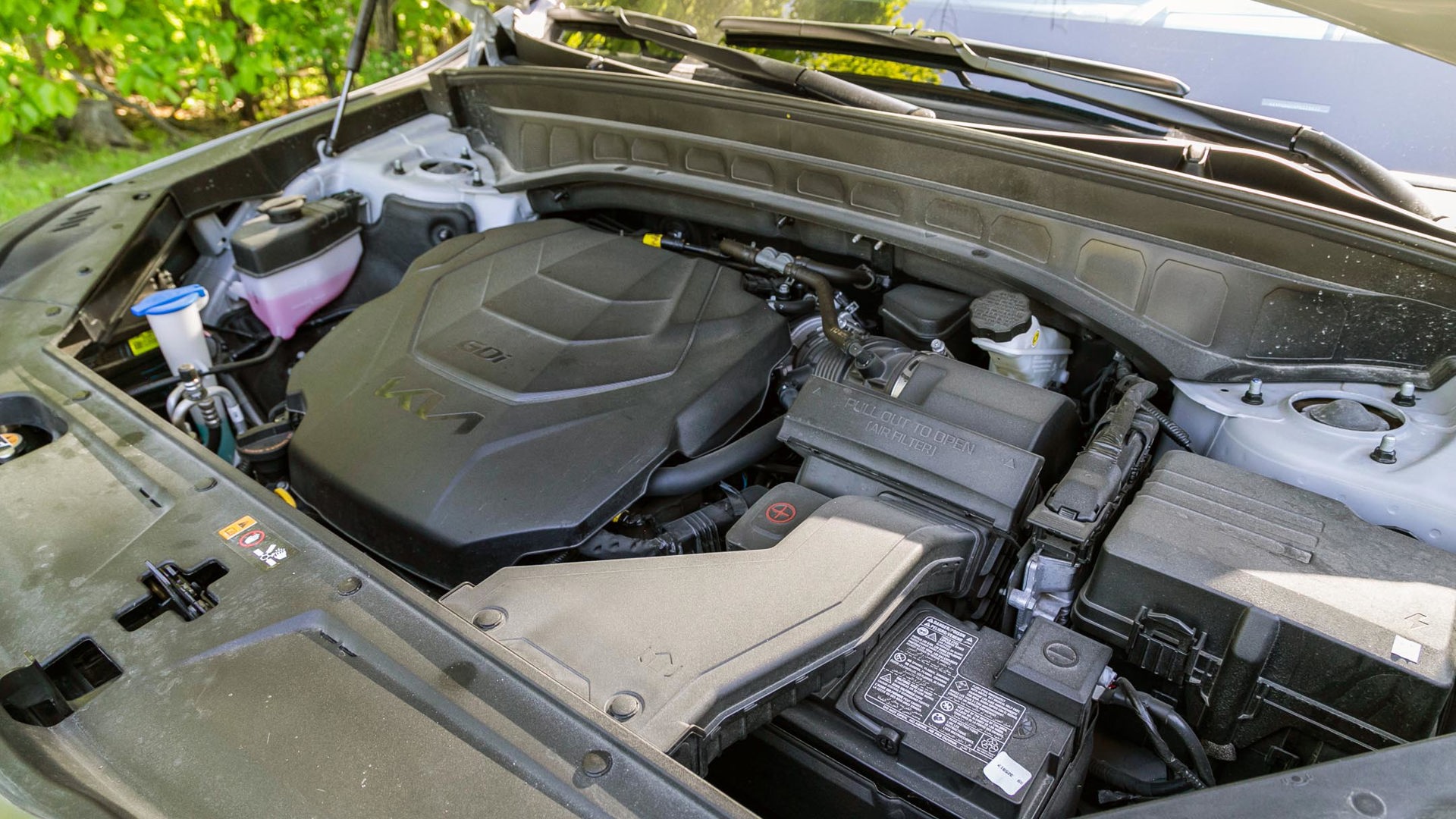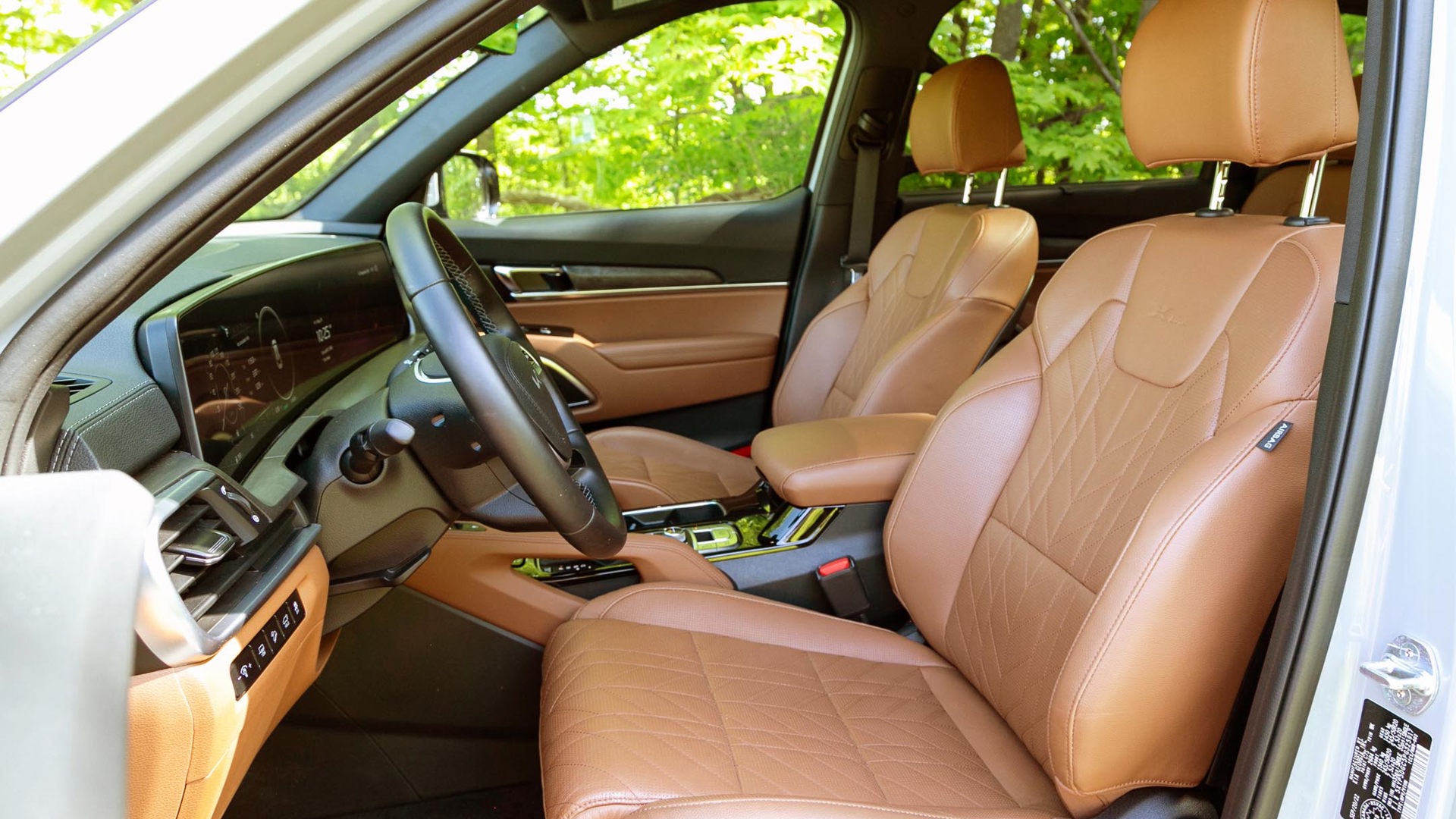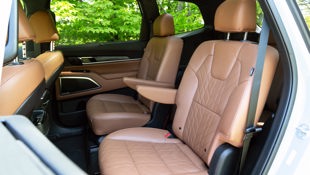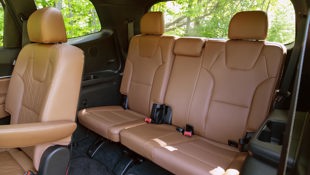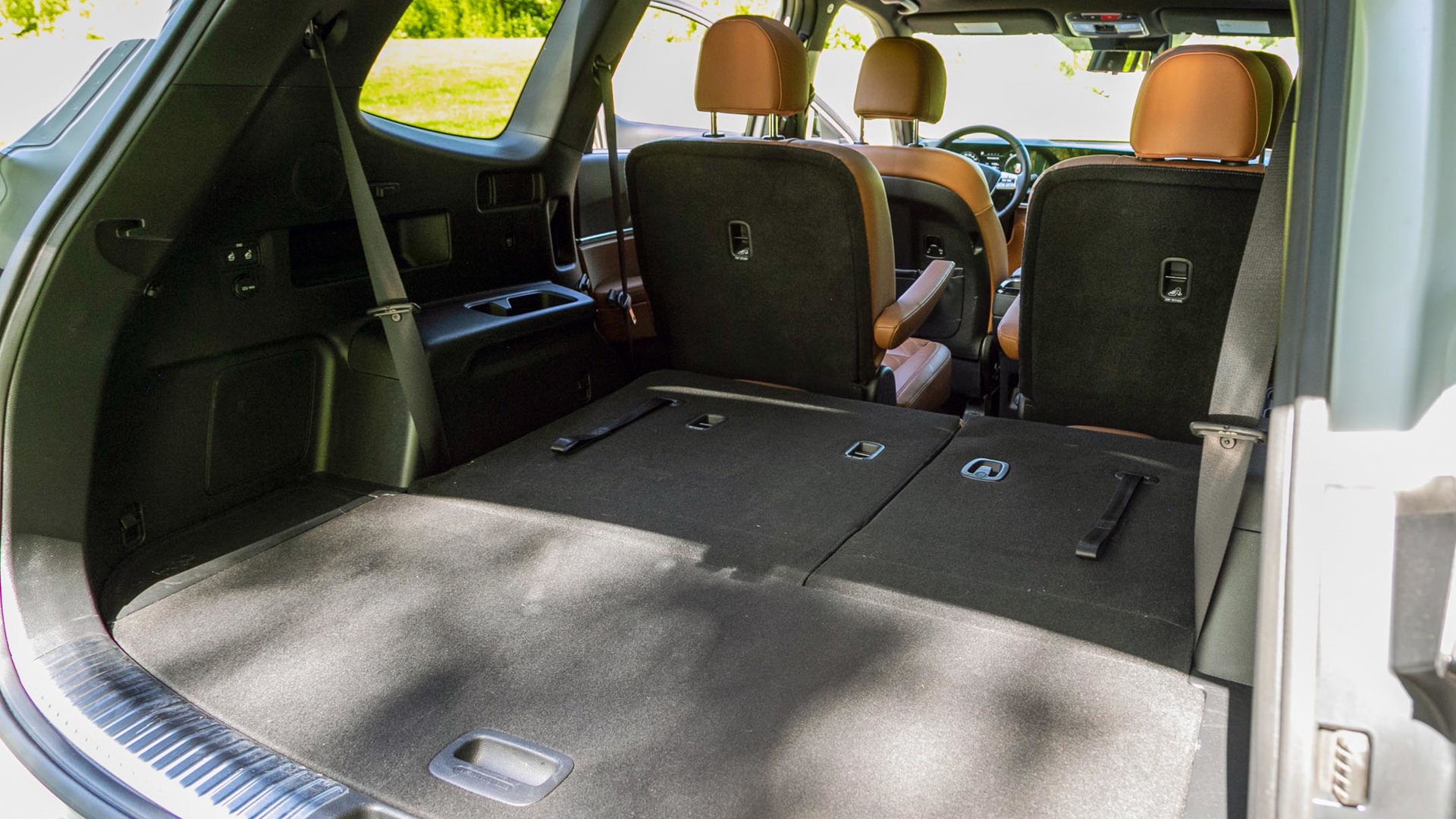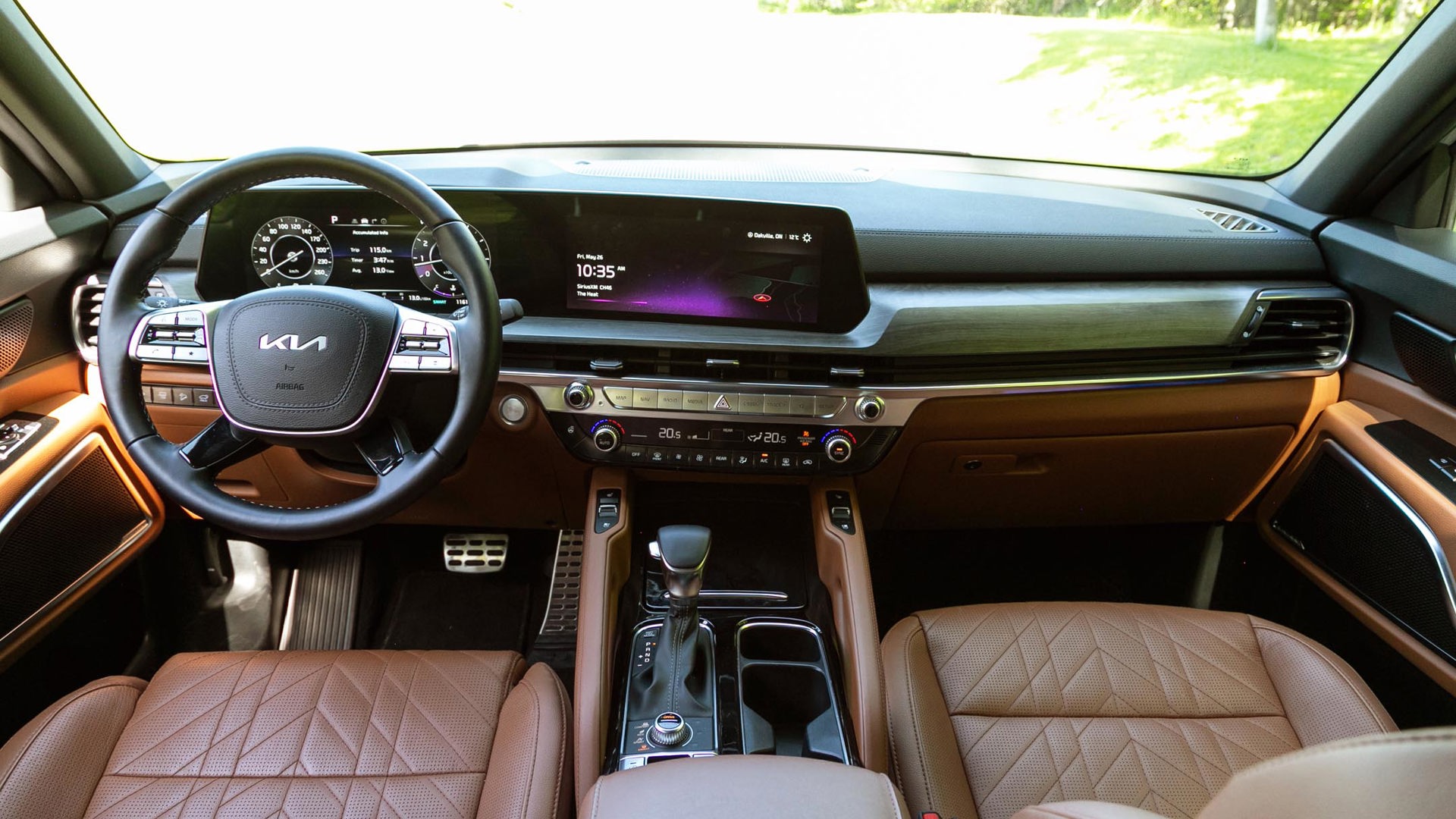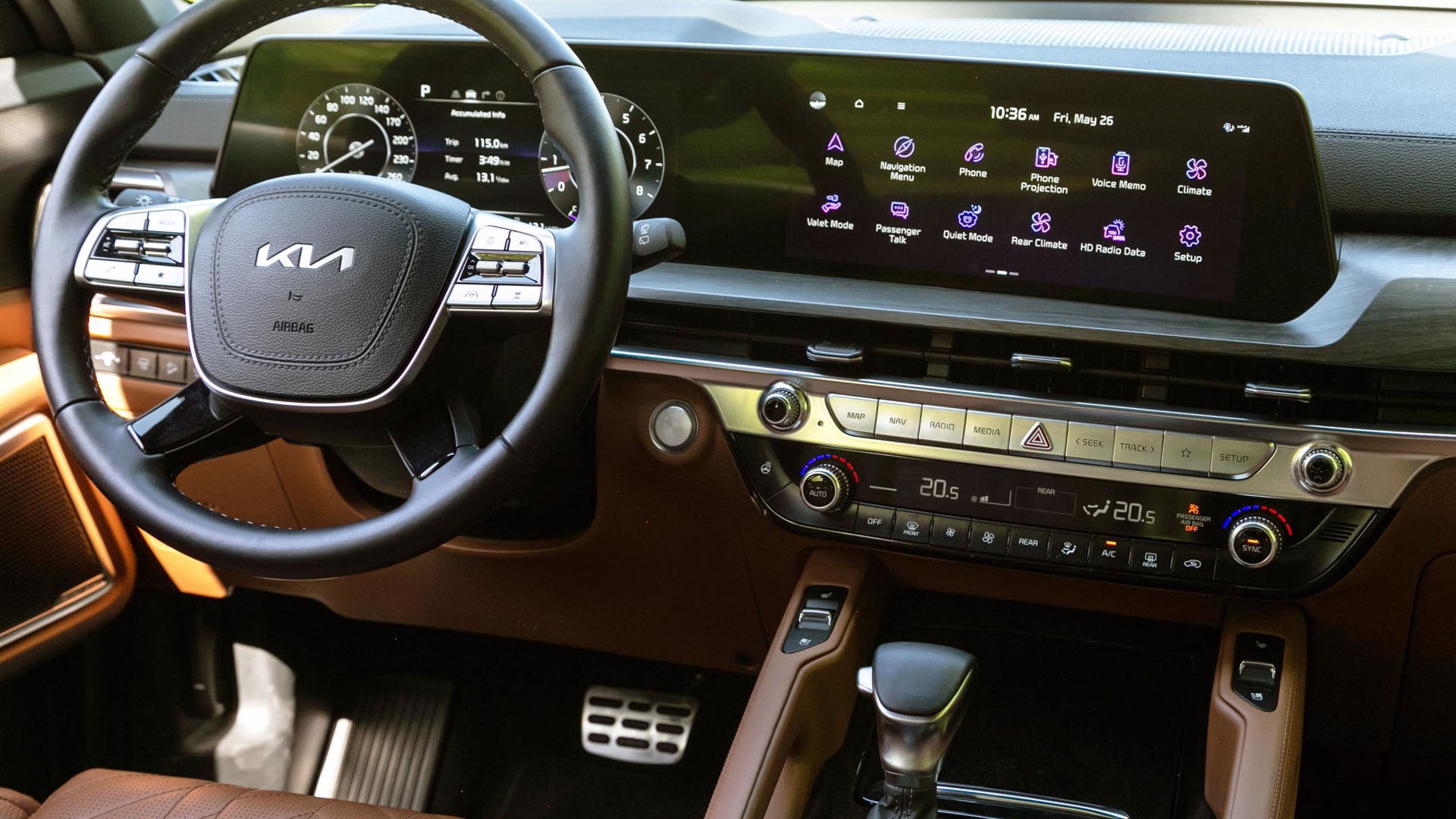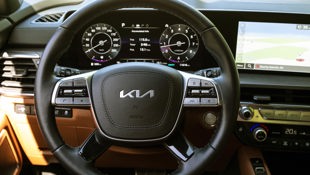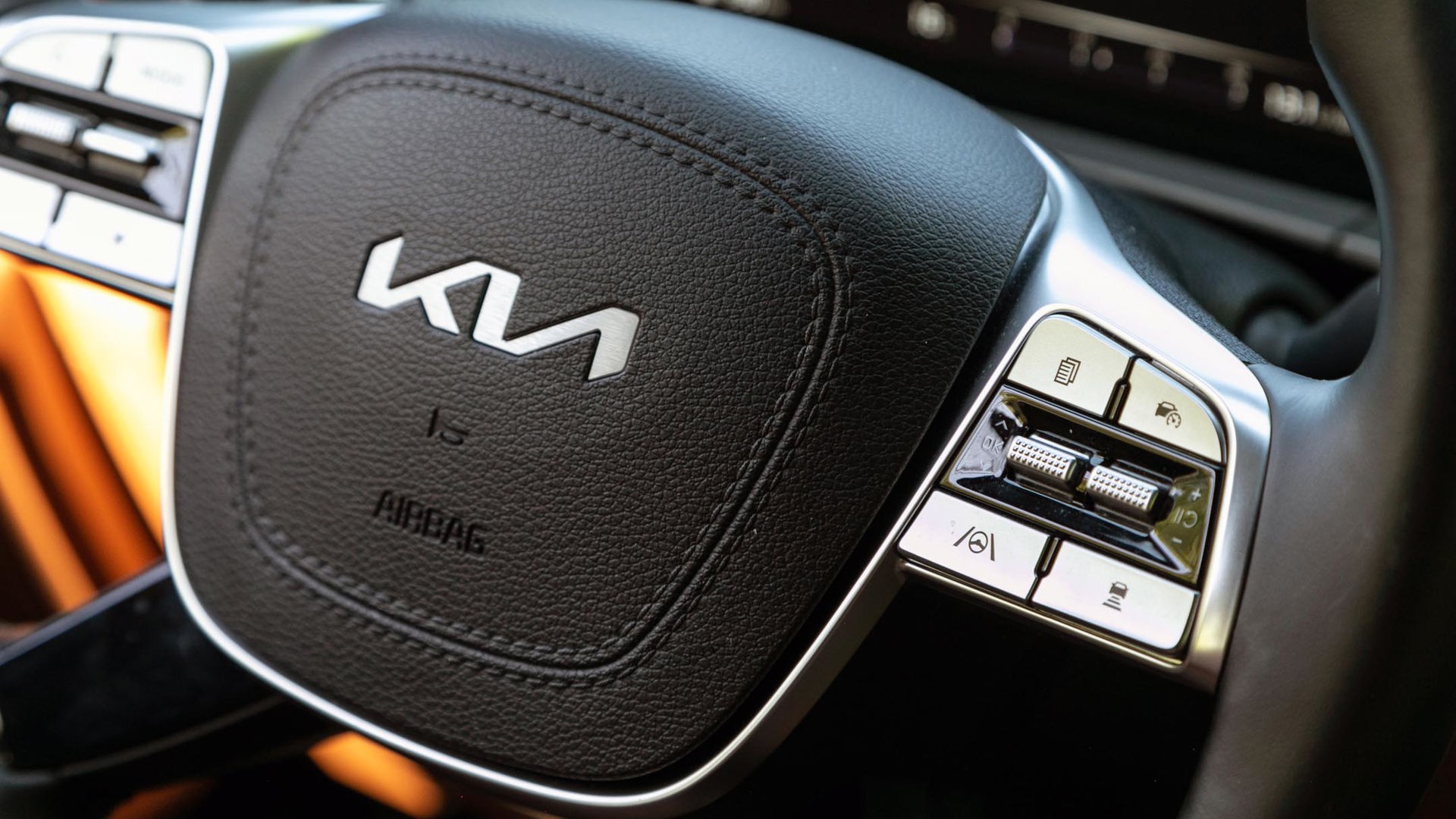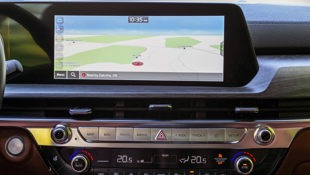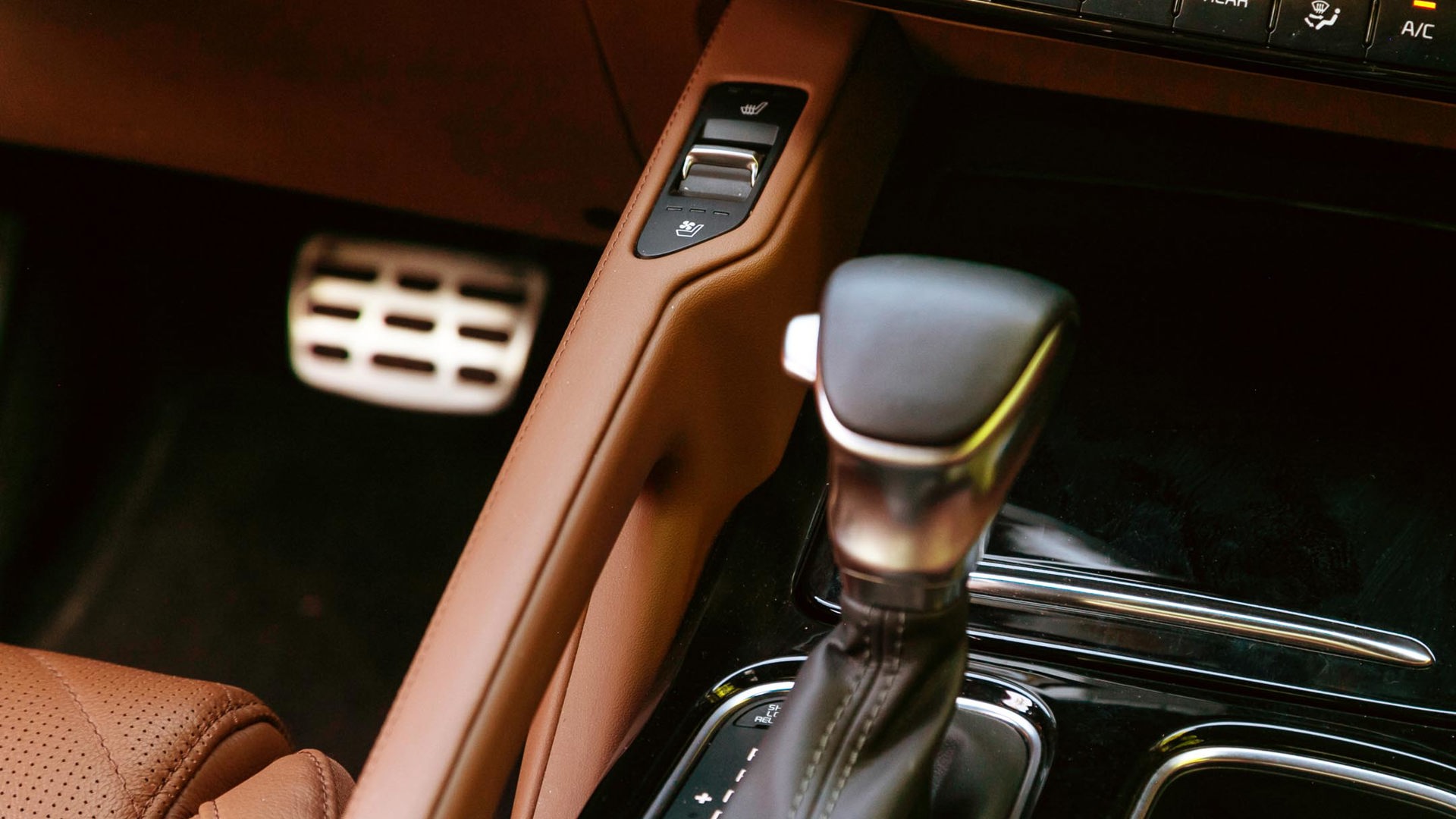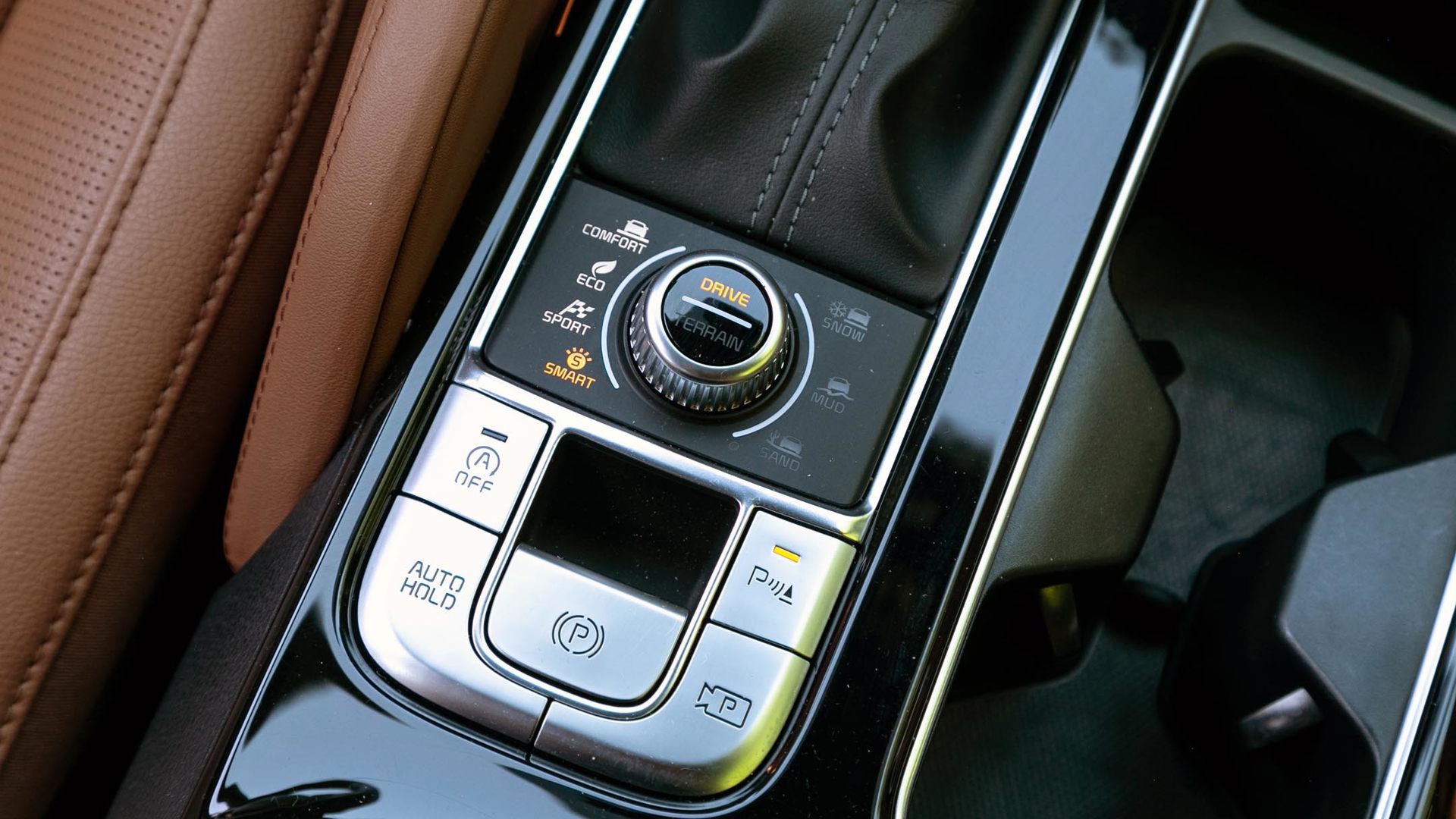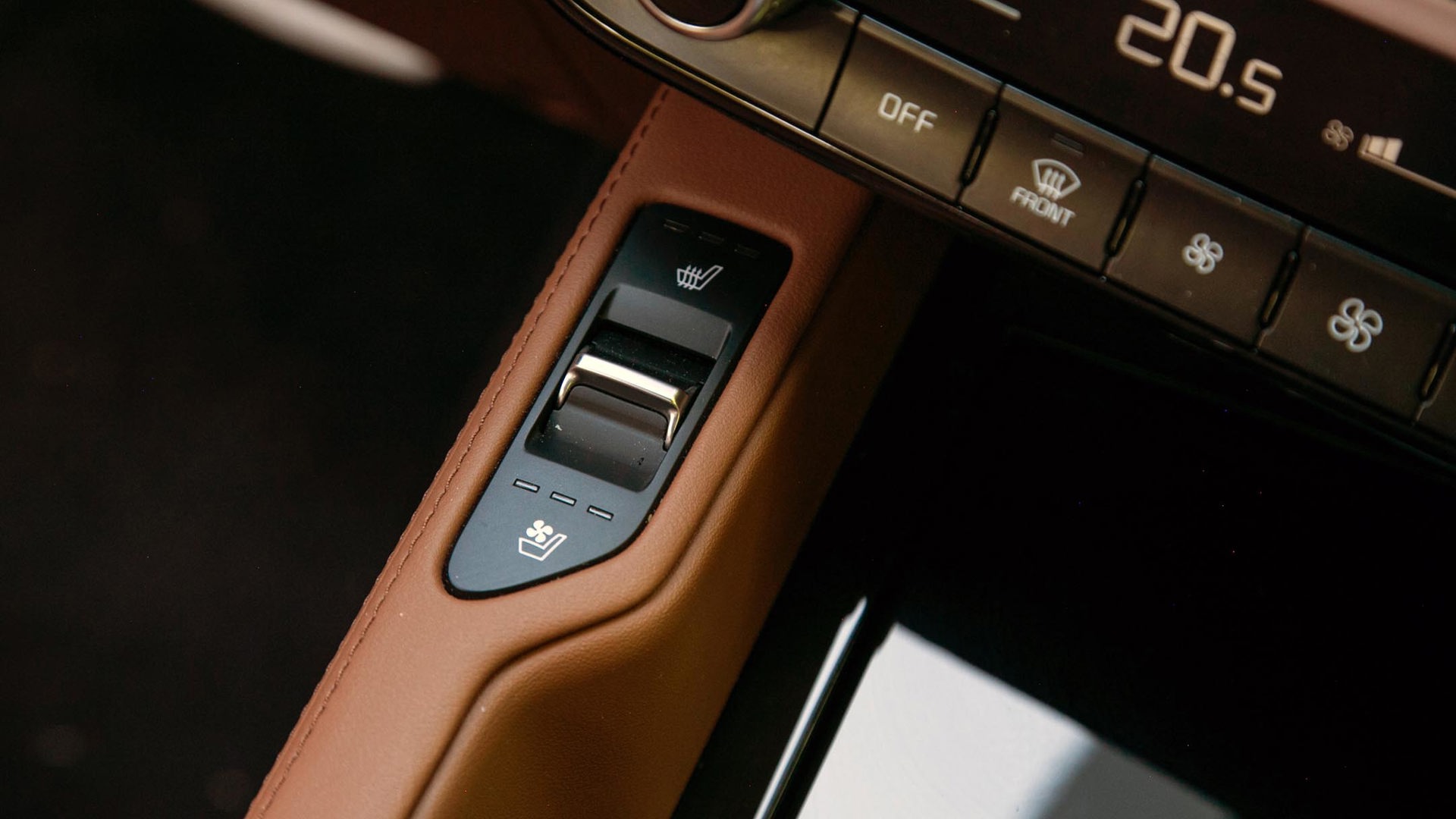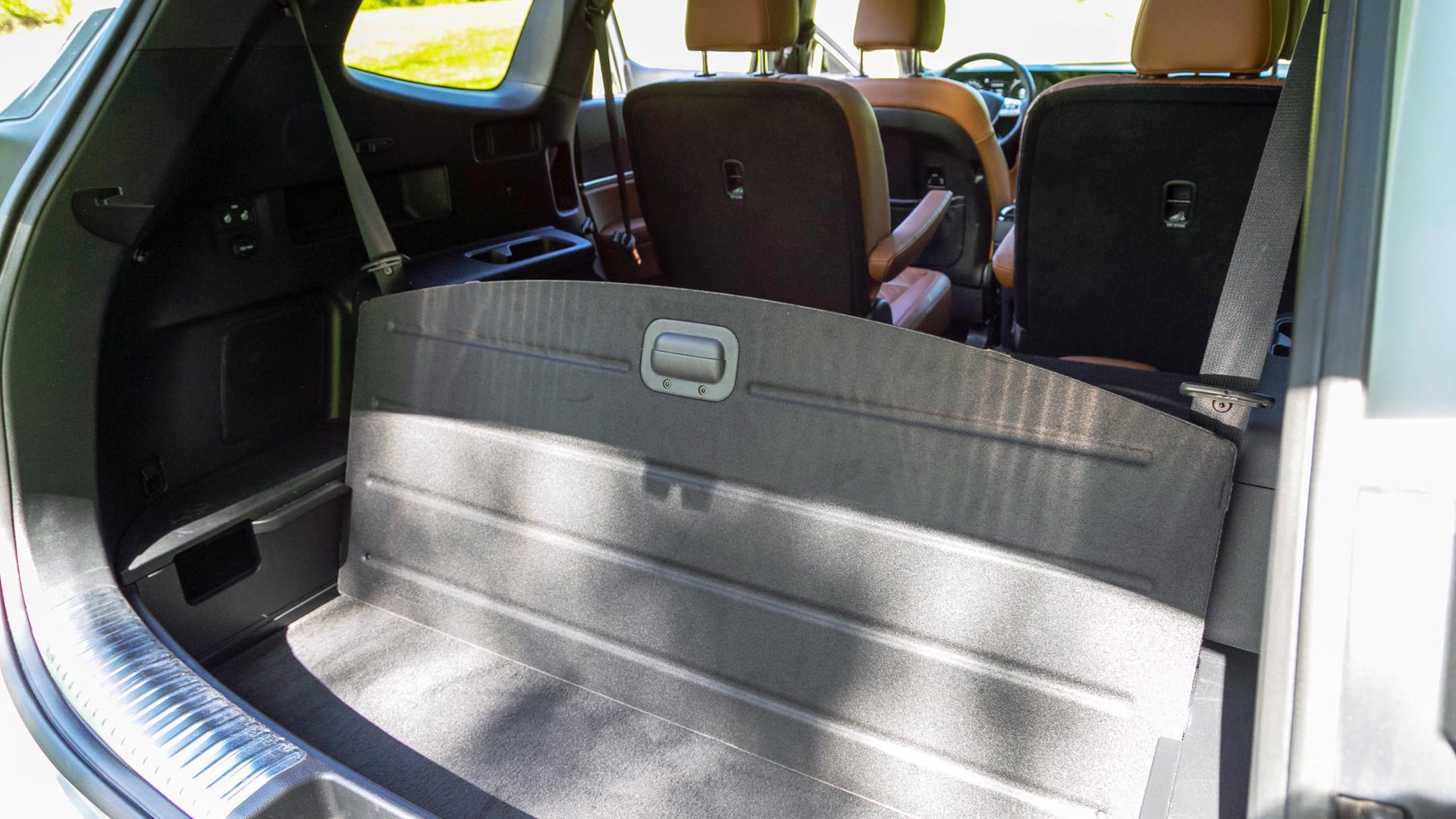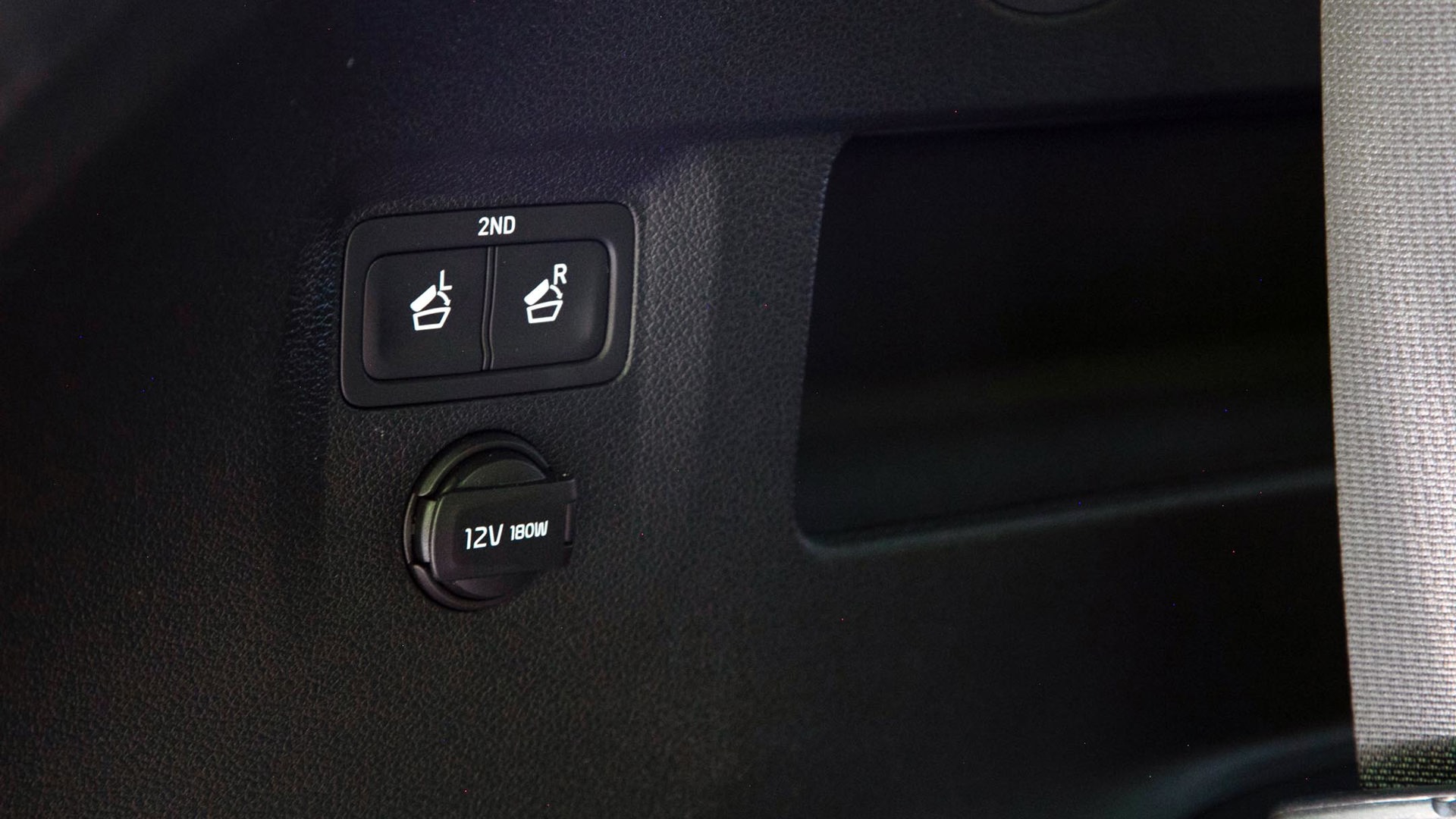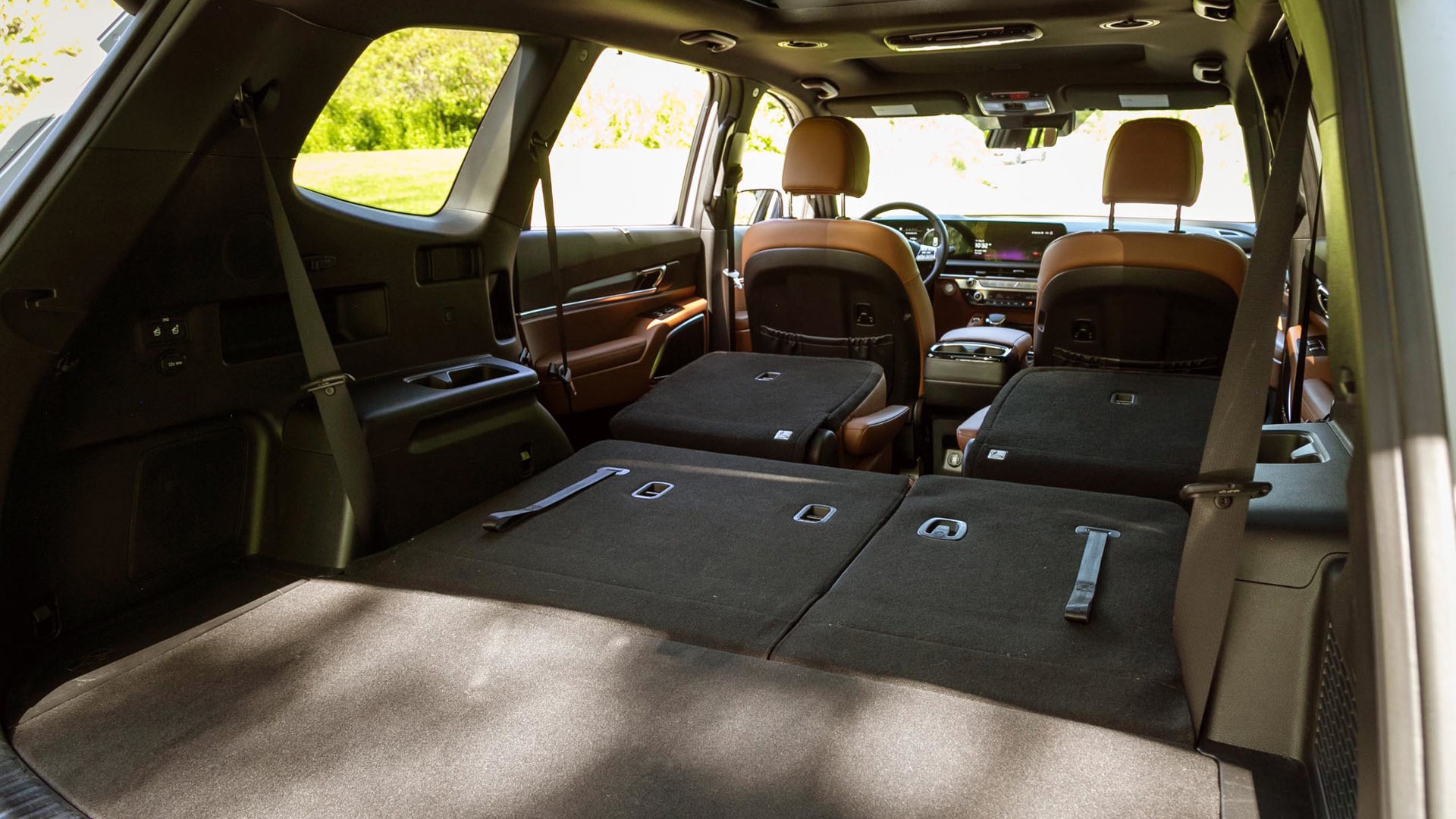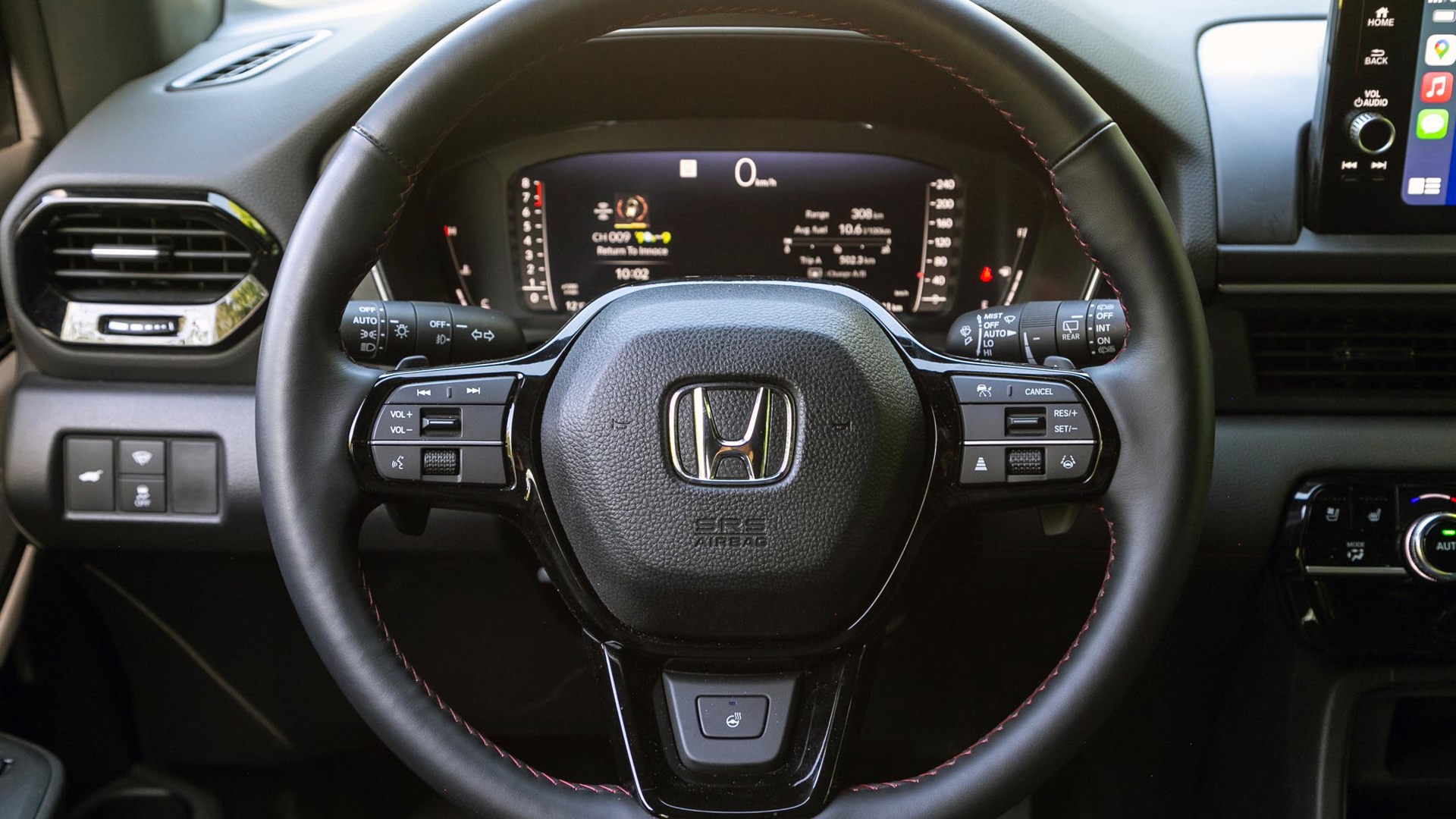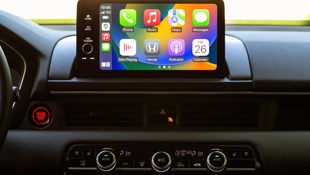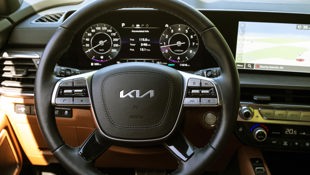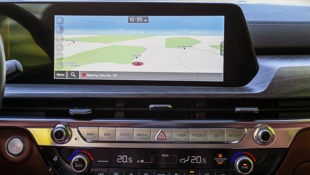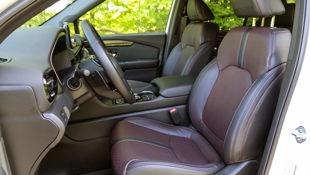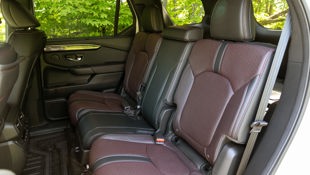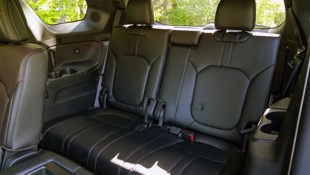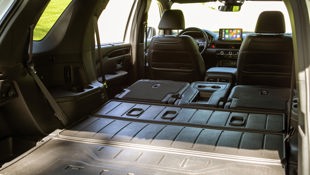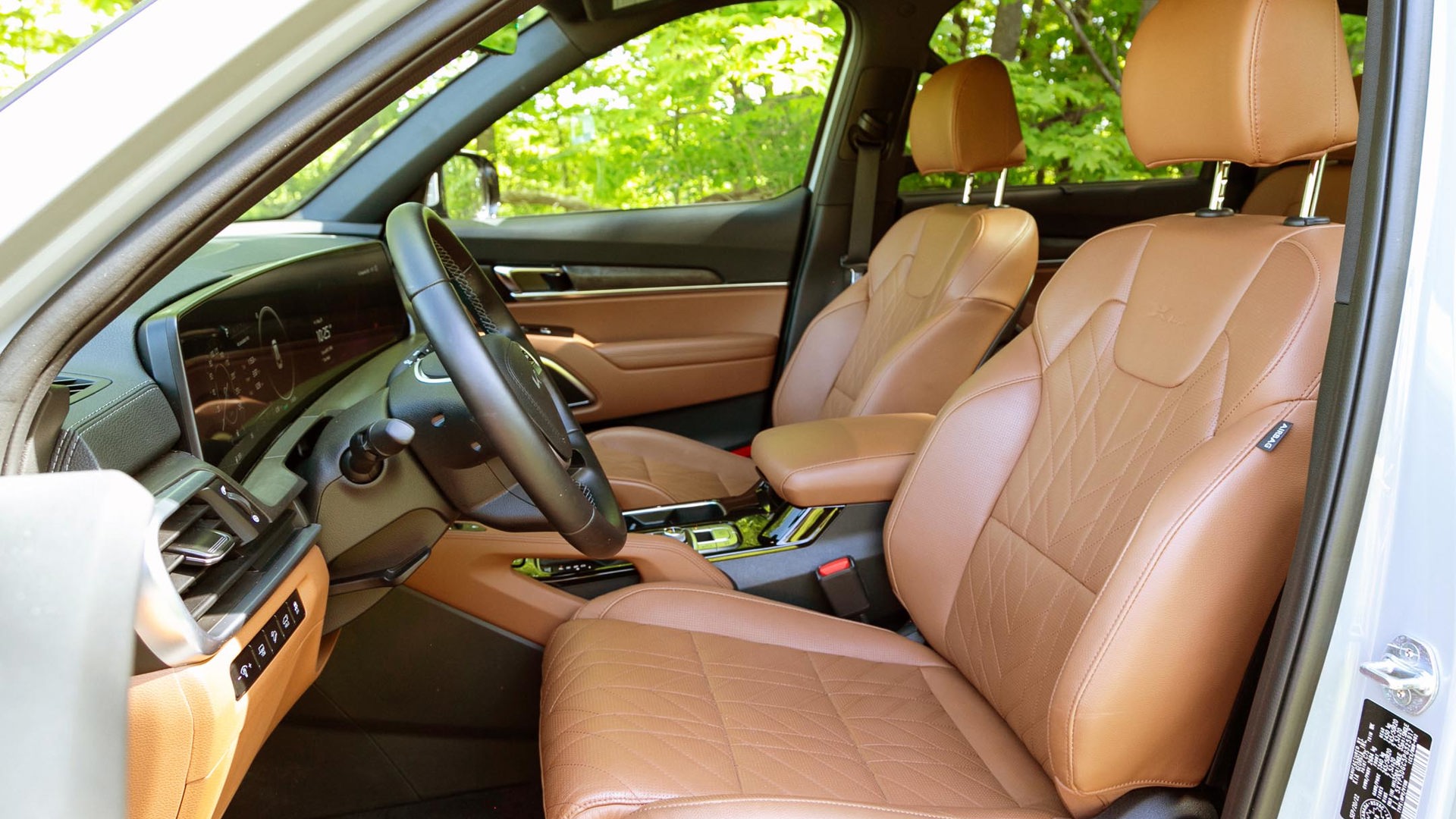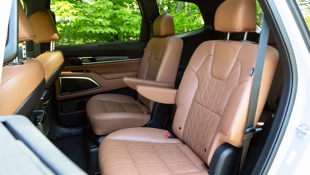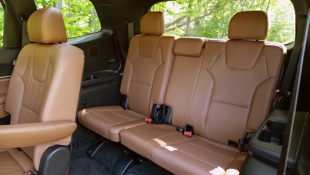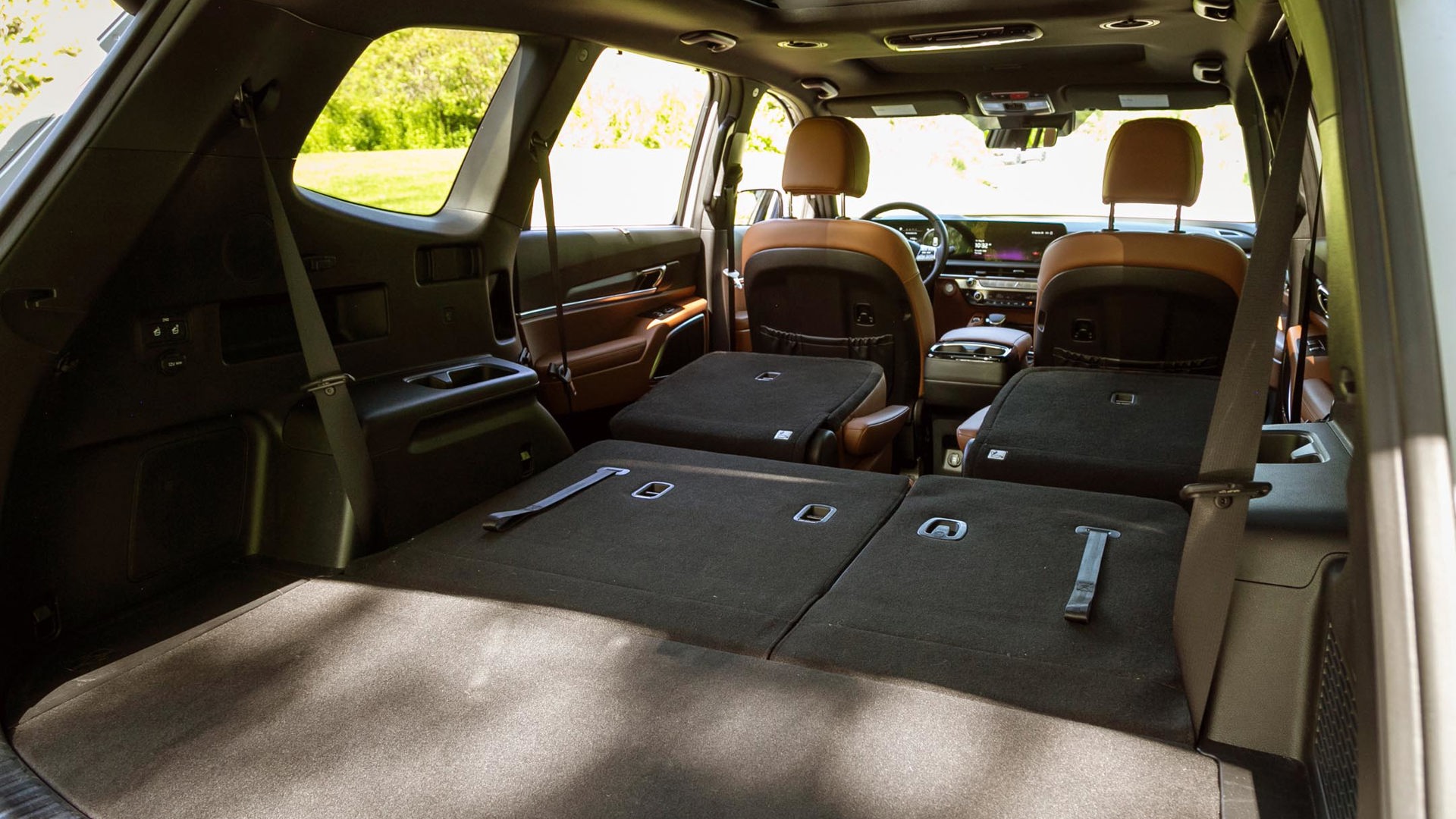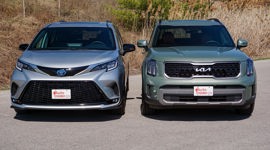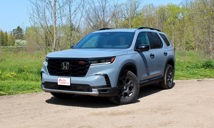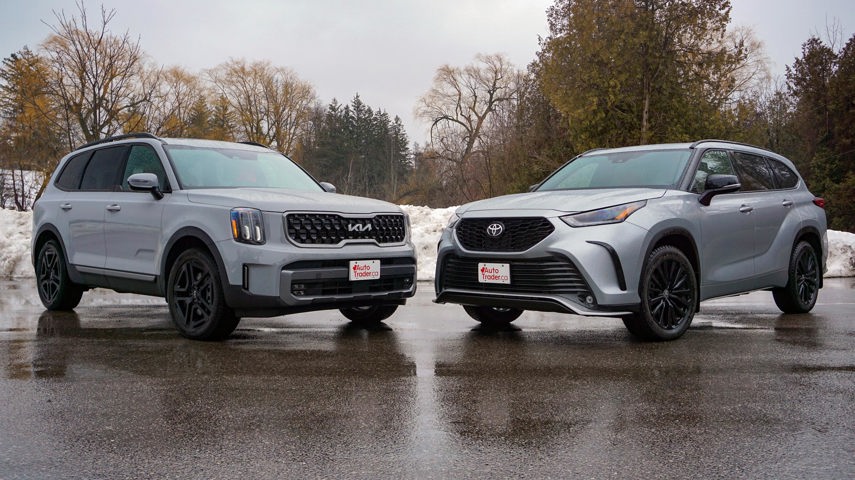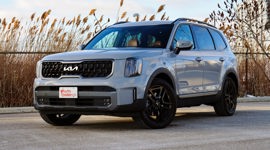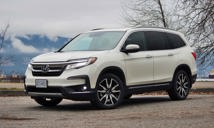Comparison Data
|
2023 Honda Pilot Black Edition
|
2023 Kia Telluride X-Line
|
|---|---|
|
Engine Displacement
3.5L
|
3.8L
|
|
Engine Cylinders
V6
|
V6
|
|
Peak Horsepower
285 hp @ 6,100 rpm
|
291 hp @ 6,000 rpm
|
|
Peak Torque
262 lb-ft @ 5,000 rpm
|
262 lb-ft @ 5,200 rpm
|
|
Fuel Economy
12.7 / 9.4 / 11.2 L/100 km cty/hwy/cmb
|
12.8 / 9.8 / 11.4 L/100 km cty/hwy/cmb
|
|
Cargo Space
635 / 3,175 L rear seats up / all seats folded
|
601 / 2,455 L rear seats up / all seats folded
|
|
Base Price
$62,850
|
$61,195
|
|
A/C Tax
$100
|
$100
|
|
Destination Fee
$2,000
|
$2,549
|
|
Price as Tested
$64,950
|
$64,344
|
|
Optional Equipment
None
|
$500 – Wolf Gray paint, $250; Terracotta Brown leather, $250
|
It can be tough when you’re at the top of your game.
You’ve constantly got a big bullseye on your back while jealous wannabes take their shots. Such is life for the Kia Telluride, which has won its category in the annual AutoTrader Awards an unprecedented three years in a row. And while we’re big fans of Kia’s three-row family hauler, we’re also keen to see how newcomers measure up against this benchmark.
Recently, the 2023 Kia Telluride has found itself in matchups against a pair of Toyotas: the best-selling Highlander, and the Sienna minivan that revealed a few cracks in the Kia’s armour. Facing what could be its toughest test yet, we’re pitting the Telluride against the redesigned 2023 Honda Pilot. Those looking for a fierce fight between two well-matched combatants in the segment are in store for a good one.
Styling
There are only so many ways you can reskin a big box, and it’s unlikely either of these SUVs are going to show up in the Museum of Modern Art anytime soon. But Kia’s designers deserve credit for what they came up with here. The Telluride still stands out as a bold offering after some four years on the market, looking more premium than its mainstream position suggests.
Honda, on the other hand, has always gone a more practical route with the Pilot. Unapologetically tall and boxy and about as stylish as a pair of cargo shorts, it’s never been sexy but it’s always worked. For this latest generation, the Pilot’s side glass proportions are squatter, and its front and rear design elements are wider and flatter. The result is that it now looks more like everything else in the segment.
It’s much the same inside. The Pilot’s design prioritizes function with little flourish, while the Telluride’s available two-tone treatment and contemporary wide screens also make it look more upscale than buyers might expect from a mainstream family wagon.
Honda Pilot: 7/10; Kia Telluride: 9/10
Practicality
As far as spacious, practical interiors go, it’s tough to beat either of these SUVs (unless you’re willing to consider a minivan, of course). Both offer three rows of seating and properly usable cargo areas.
For years, Honda has been doing an amazing job at carving as many nooks, cubbies, and cup holders into its SUVs’ cabins, and the 2023 Pilot is no exception. Regardless of whether sitting up front, in the middle row, or in the back of the bus, there are spots throughout for drinks, phones, and whatever else families travel with.
The Telluride is good, too, but its third-row seating is notably tighter than the Pilot’s – plus, in the upper trim tested here, the second row comes fitted with a pair of captain’s chairs instead of the split-folding bench found in the Honda. Better still, the Honda’s second row features a 40/20/40 split that means with the middle section folded forward it offers the same separation between two bickering siblings while providing the option to accommodate as many as eight occupants when needed.
The Pilot’s cargo capacity is also significantly greater than the Telluride’s both behind the third row and with all the seats folded flat, plus the in-floor cubby is larger, too. Those planning to tow should note the Kia’s 2,268-kg (5,000-lb) limit versus the Honda’s 1,588-kg (3,500-lb) rating.
Honda Pilot: 9.5/10; Kia Telluride: 9/10
Comfort
Don’t get too hung up on interior measurements, because while the Honda’s third row offers more space, the bench back there isn’t quite as comfortable. The Kia’s bench is perched a bit higher, giving a bit more under-thigh support. But in the second row, the Pilot’s bench seat is significantly more comfortable thanks to better padding; the Telluride’s captain’s chairs feel like cardboard-over-concrete in terms of their suppleness and support. Up front, both machines offer thrones that are heated and cooled, but again, the Pilot’s padding is comfier, making those the seats we’d rather have for a road trip.
Sound isolation is quite good in both SUVs, as is ride quality – though again, the Honda seems to soak up road imperfections slightly better than the Kia.
Honda Pilot: 8.5/10; Kia Telluride: 8/10
Features
These being top trims, both SUVs in this head-to-head are very well specced. Tri-zone climate control, leather seating, head-up displays, panoramic sunroofs, second-row window shades, and premium stereos are included in both, and while the Telluride’s second-row seats are also ventilated, its infotainment system still can’t handle wireless smartphone connectivity the way the Pilot’s can.
The Telluride’s second-row seats can be electrically folded forward from the cargo area, but the Pilot has a brilliant feature that enables a delayed closing of the rear hatch. Simply push the button, then gather up an armful of cargo and walk away; the hatch won’t close until you’re safely out from under it.
Honda Pilot: 9/10; Kia Telluride: 9/10
Safety
The Kia Telluride received a Top Safety Pick+ rating from the Insurance Institute for Highway Safety (IIHS) and a top five-star rating from the United States National Highway Traffic Safety Administration (NHTSA), but neither organization had published their ratings for the new Pilot at the time of this writing.
Even still, both of these manufacturers should be commended for their commitment to safety, filling each of these models with comprehensive suites of active and passive features. Honda throws everything it’s got into every Pilot, with even the base trim getting all the collision warning, lane-keeping, and blind-spot monitoring systems it offers.
Kia’s safety suite is similarly comprehensive across the Telluride lineup, with the exception of the base trim not getting the camera-based blind-spot monitoring setup that shows either side of the vehicle in the instrument display when the corresponding signal is activated; it gets a more conventional sensor-based system instead. The base trim also misses out on some of the more advanced forward collision monitoring for lane changes and junction crossings.
Honda Pilot: 9.5/10; Kia Telluride: 9/10
User Friendliness
Both of these SUVs sensibly blend high-tech screens for both infotainment and instrumentation with a myriad of real buttons, knobs, and dials. The layouts are sensible and intuitive, taking very little time for a driver to acclimate despite the considerable amount of tech on hand. Several premium automakers could learn a thing or two from either layout.
The Kia’s screens are larger, and their seamless integration using a single panel looks a little slicker, but it’s no more usable than the Honda’s primary screen that’s perched high atop the dash closer to the driver’s line of sight. Even functions like switching on seat or steering wheel heaters are done via buttons that are close to hand.
Kia takes the win in this category for its traditional and more usable gear selector knob versus Honda’s pedantic push-buttons that are tedious at the best of times and downright hair-raising when you’re frantically mashing buttons trying to get out of the way of traffic having just backed out of a driveway.
Honda Pilot: 8/10; Kia Telluride: 9/10
Power
With most of the competitors in this segment having moved to turbocharged four-cylinder engines, both the Honda Pilot and Kia Telluride (and the latter’s corporate cousin, the Hyundai Palisade), hold fast with smooth, naturally-aspirated V6s. The Kia’s larger 3.8L just barely bests the Honda’s 3.5L in terms of output, dispensing 291 hp versus 285. Besides supposed fuel savings, the move to smaller engines elsewhere is also motivated by snappier responsiveness afforded by the low-end torque of the turbocharged engines. These two deliver an identical 262 lb-ft of torque, but they require at least 5,000 rpm to achieve.
The Honda’s 10-speed automatic transmission does a better job of keeping the engine in the powerband’s sweet spot, meaning it feels more responsive to throttle inputs under normal driving than the Kia. What’s more, the Kia’s shifts aren’t as crisp with its eight-speed automatic, nor is its engine as free-revving in feel, making it just a little more sluggish around town.
Once up to highway speed, both machines are smooth operators that do wonderful jobs of comfortably and quietly gobbling up distances with ease. Both have sufficient passing and merging power and are well-suited for family-hauling duties, too.
Honda Pilot: 8.5/10; Kia Telluride: 8/10
Fuel Economy
The downside to big, heavy SUVs with relatively large V6s is that they aren’t exactly miserly in their fuel consumption. While these two are happy to slurp regular-grade gas, they do so at a similar rate of just over 11.0 L/100 km combined.
Government figures peg the Pilot as slightly more efficient, but during a shared test loop of mixed urban and rural driving, the Honda showed a consumption rate of 10.8 L/100 km while the Kia’s computer boasted a comparatively thrifty 9.5 L/100 km.
Honda Pilot: 7/10; Kia Telluride: 7/10
Driving Feel
Both of these SUVs are designed to comfortably keep three rows of people and pets safe and secure, and as such, neither is exactly sporty in its on-road behaviour. Still, despite its size the Pilot still manages to show off an element of driving enjoyment that’s missing from the Kia, with the Pilot’s throttle and transmission responsiveness just that little bit more engaging. And when driven quickly, the Pilot is a big, roly-poly SUV, but its suspension keeps it better composed during quick steering inputs – say, when avoiding an errant animal on the road.
Honda Pilot: 7.5/10; Kia Telluride: 7/10
Value
In base trim, the Telluride and Pilot start within $100 of each other. Our test units represented the most luxurious trims for both (the Telluride’s range-topping X-Pro adds some quasi-rugged features that Honda puts on its mid-pack TrailSport trim).
At $64,244 before tax with its terra cotta-hued interior and Wolf Grey paint, the 2023 Kia Telluride X-Line rings in just a shade less than the $64,850 pre-tax price of the 2023 Honda Pilot Black Edition, making these two among the costliest in the mainstream midsize segment. Buyers planning to keep their purchase for the long haul may want to factor in Kia’s notably better five-year comprehensive warranty versus Honda’s three-year coverage.
Honda Pilot: 6.5/10; Kia Telluride: 7/10
The Verdict
The Telluride remains an excellent choice among mainstream three-row SUVs, but the competition certainly hasn’t been asleep at the wheel, and even with its minor updates for 2023, fresh competitors like this new Honda Pilot are looking to steal its thunder. The Pilot has always offered great interior space and functionality within an easy-to-live package, and the new one only improves it. Carrying on with its well-liked V6 and slightly more engaging road manners gives the 2023 Honda Pilot a slight edge over the Kia, making it our pick of these two. Don’t look now, but the Telluride’s reign as AutoTrader’s top pick in the segment may soon be coming to an end.
